

INSIDE STORY
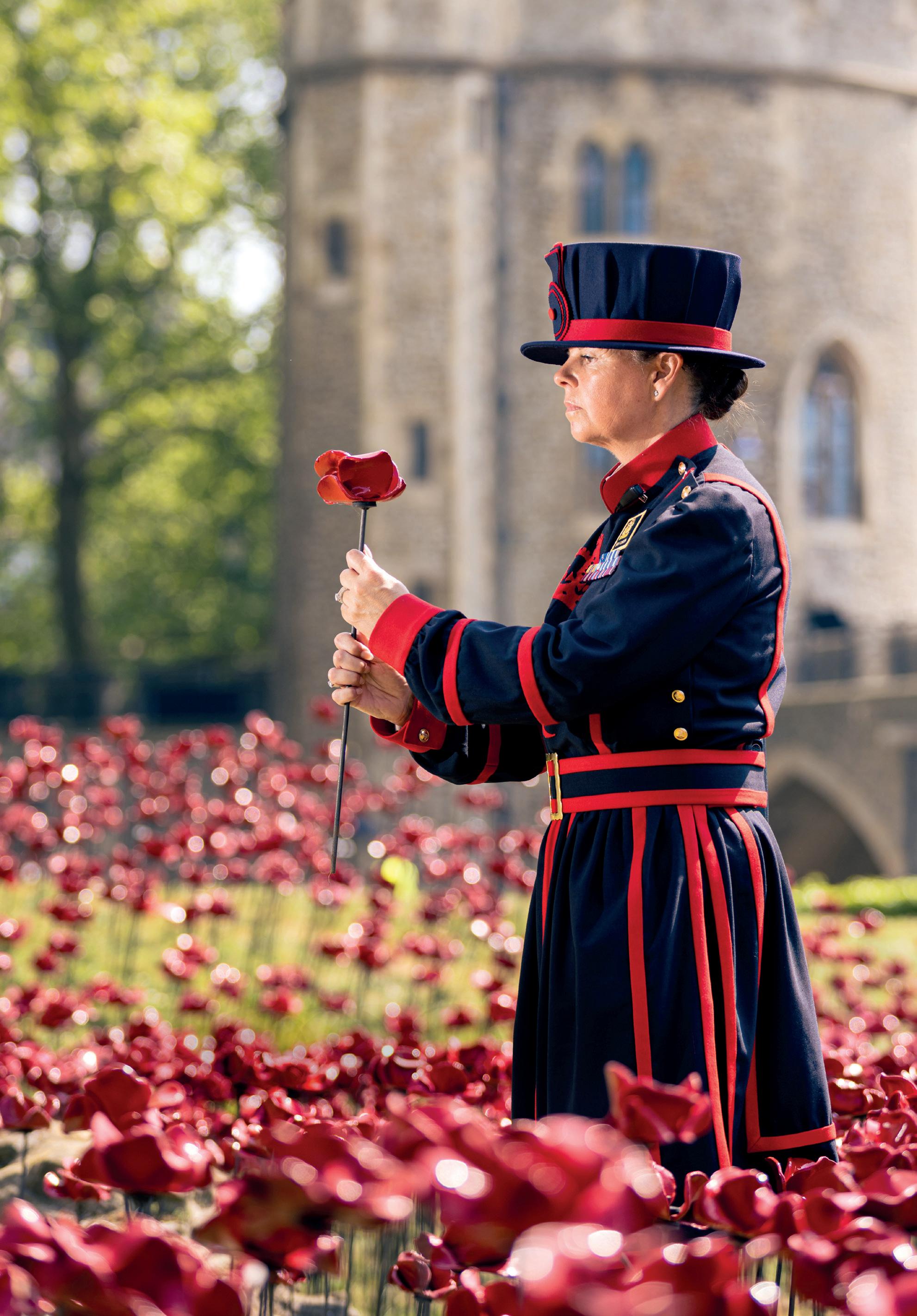
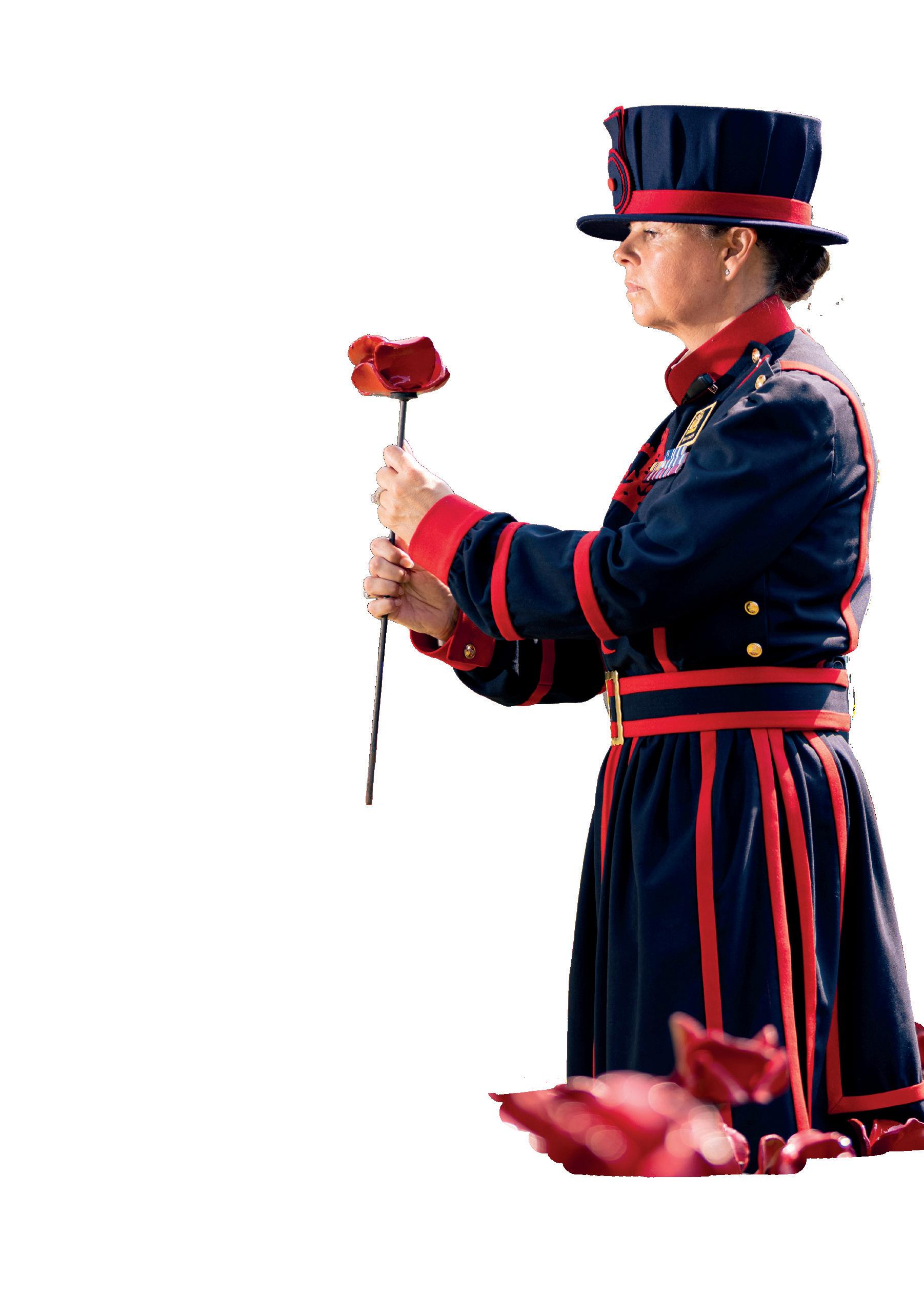
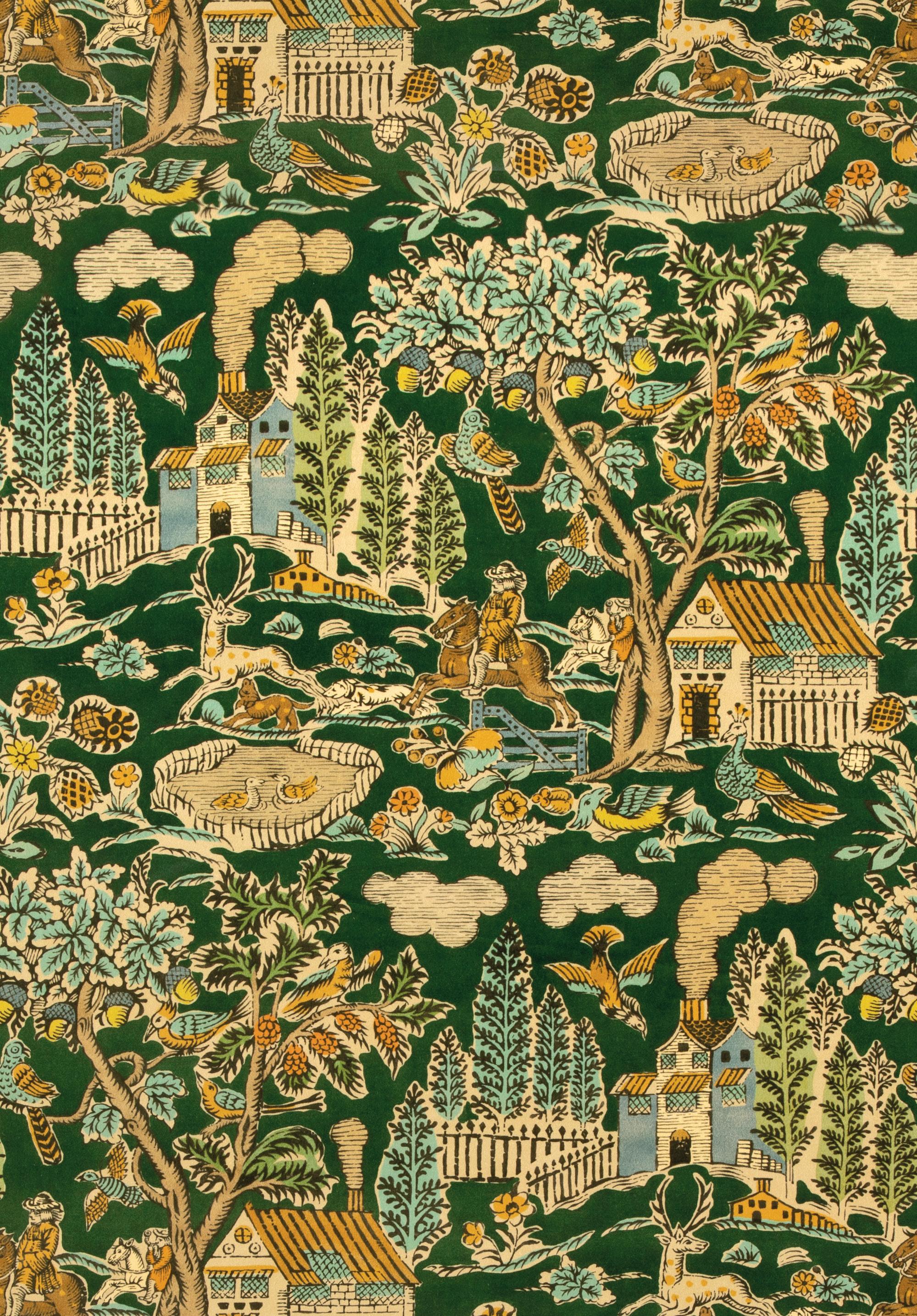
GIFT AID YOUR MEMBERSHIP
Historic Royal Palaces is an independent charity, and we rely on your support to continue to preserve the magnificent palaces and gardens in our care.
If you’re a UK tax payer and have not yet opted-in to Gift Aid, please email us at members@hrp.org.uk, and we can claim an extra 25p per £1 of your membership fee from the government, at no extra cost to you
WELCOME…

… to our autumn/ winter issue.
At this time of year our thoughts turn to Remembrance, and on 11 November our poppies installation ‘The Tower Remembers’ culminates in a ceremony for Armistice Day. This stunning display, which opened in May, is accompanied by a specially commissioned poem by Poet Laureate Simon Armitage. He talks about writing ‘In Retrospect’ on page 34.
Buildings Curator Alfred Hawkins shares some less sombre (or perhaps we should say sober!) memories, revealing the centuries-long history of Tower Taverns (page 16). If you’re fond of a good mystery, you’ll enjoy The Stolen Crown (page 24) as Chief Historian Tracy Borman investigates skulduggery behind the Stuart succession.
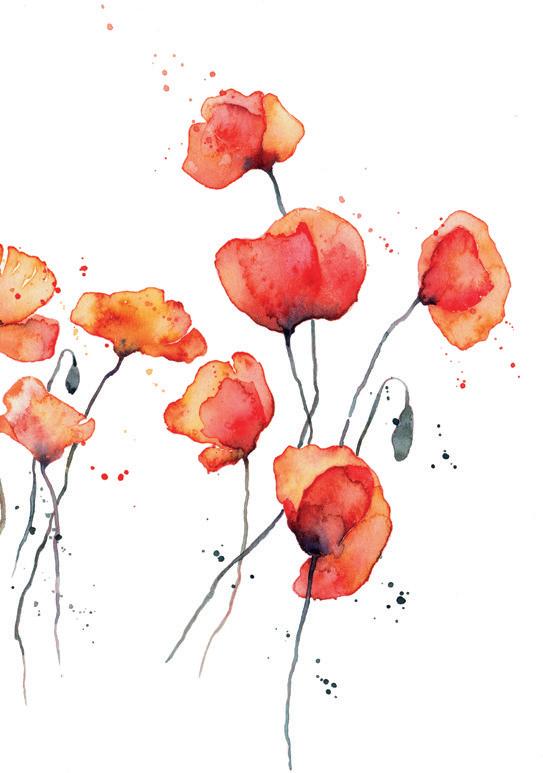
Published by Historic Royal Palaces, Hampton Court Palace, Surrey, KT8 9AU.
In-house editor: Clare Murphy
External editor: Sarah Kilby © Historic Royal Palaces 2025. All rights reserved. No part of this publication may be reproduced or transmitted in any form or by any means, electronic or mechanical, including photocopying, recording or any information storage or retrieval system, without permission in writing from the publisher.

History is great, isn’t it? And it really matters, to all of us. The best teachers can instil a valuable passion for the past, but their skills and imagination are not always widely recognised. That’s why Historic Royal Palaces is launching the first ever Inspiring History Teaching Awards, to find the UK’s most inspiring and innovative history teacher, whether primary, secondary or special school. We need your nominations now (page 30)!
And we haven’t forgotten Christmas, both past – Christmas with Queen Victoria (page 38) – and present, literally, with a lovely selection of seasonal gifts all with your 10% members’ discount (page 44).
Enjoy the season!

Angie Faires Head of Marketing and Membership
Unless otherwise stated, all images are © Historic Royal Palaces.
Historic Royal Palaces is a registered charity (No 1068852)
Contact us: insidestory@hrp.org.uk
Left Detail of the new 'Home Park' wallpaper, inspired by a fragment preserved on a wall behind the scenes at Hampton Court Palace (see page 46).
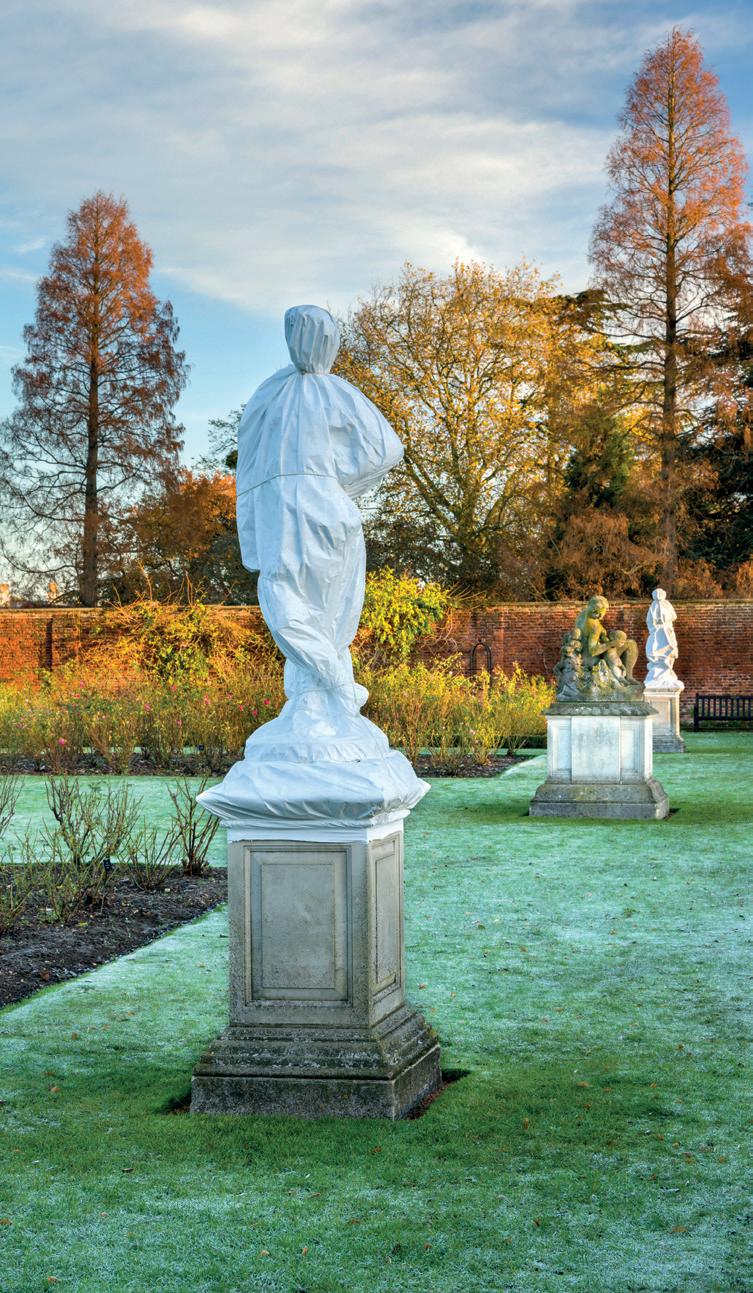

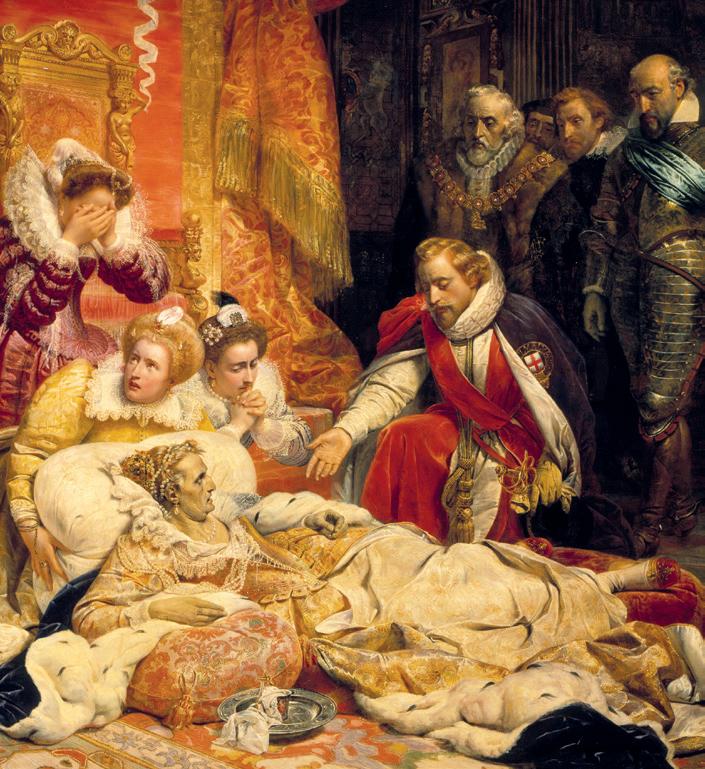




MAKING
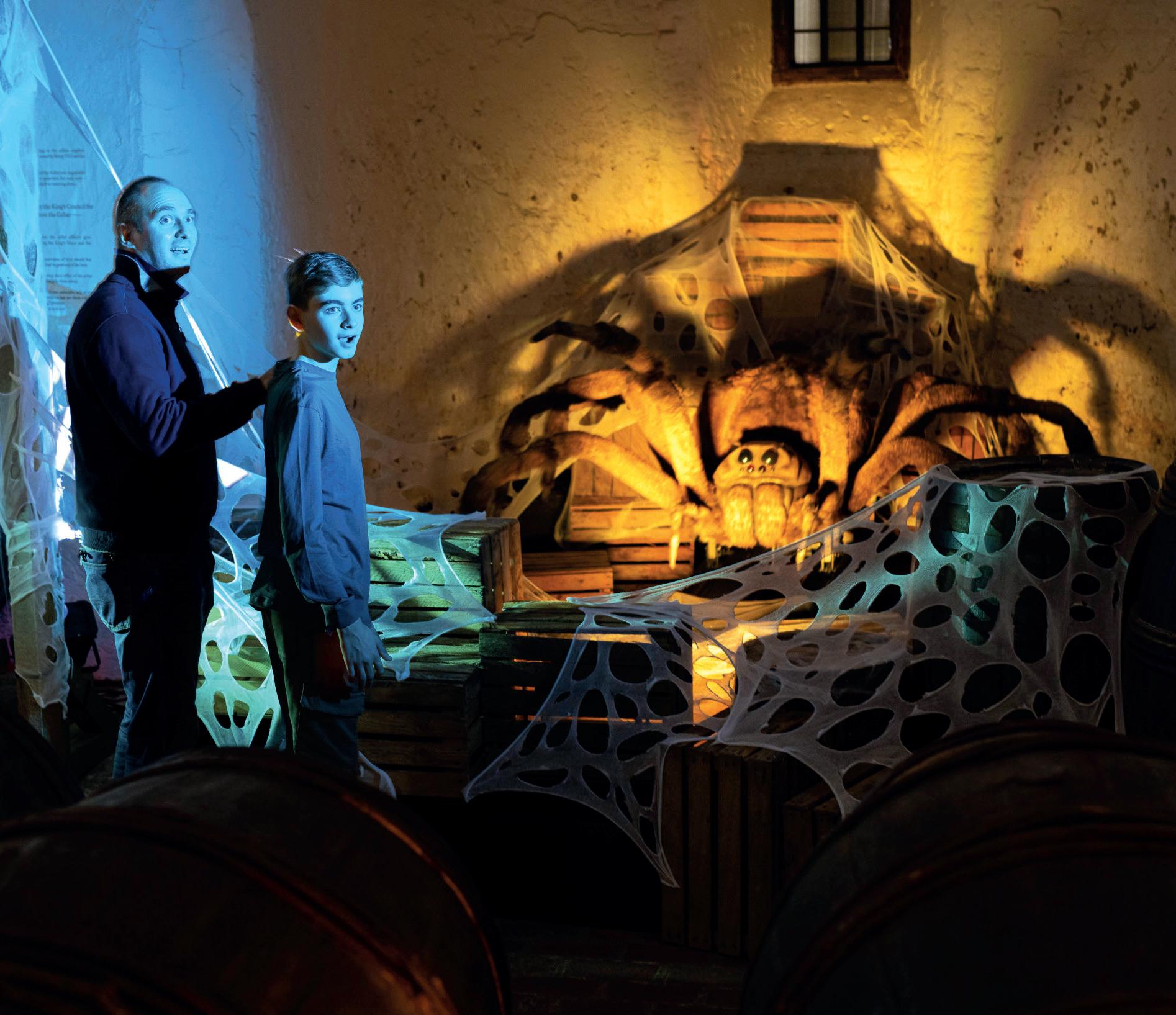
AUTUMN INTO WINTER
Make the most of your membership when you visit our wonderful palaces and gardens.
NEED TO KNOW
Tips to help you enjoy your membership.
PLANNING YOUR FREE VISIT
As a member, you can enjoy free, unlimited entry to some of the UK’s most iconic palaces: Tower of London, Hampton Court Palace, Kensington Palace and Hillsborough Castle and Gardens, as many times as you like.
You only need to pre-book free tickets on select event days; at all other times, simply show your membership card. Visit hrp.org.uk and search What’s On or see your member email newsletters for opening hours and booking requirements.
We’re introducing a new and improved way to manage your membership and book member tickets online. Look out for email updates or see our dedicated FAQs via the ‘Member login’ button at the top of hrp.org.uk.
UNMISSABLE EVENTS
As a member, you benefit from free or discounted entry to a wide range of events including special exhibitions, festivals and fayres. Plus, enjoy an exclusive programme of members-only events including tours, talks, behind-the-scenes peeks and much more throughout the year.
Visit hrp.org.uk/whatson-all-the-palaces to find out if you should pre-book your tickets.


THANK YOU
The Banqueting House is preparing to reopen on select days after substantial works. We are grateful to The Garfield Weston Foundation and The Wolfson Foundation for supporting this project. And thank you to you, our members.
We can’t wait to welcome you back! Check our What’s On page for details on your upcoming Members’ Days and for booking requirements.
DISCOVER MORE
EXPLORE THE VAULT

GREAT SAVINGS
Bring your membership card on every visit to enjoy 10% off in our shops and cafés, plus enjoy 10% off in our online shop with code MEMBER25* From 28 November to 01 December, enjoy 20% off in shops, online and on-site. Plus, pick up a Member Royal Reward Card in one of our on-site cafés to collect stamps and get your 6th hot drink free!
*Exclusions may apply
Unlock behind-the-scenes digital content, curated especially for members, on your digital hub. Get closer to the palaces and our history through expert interviews, thoughtprovoking podcasts, videos and fun family activities. See page 29 to discover more about your new membersonly Halloween Quiz.
Have a moment? We’d love to know what you think of your latest members-only video. Watch the video and find the link to the short feedback form on The Vault.
STAY IN TOUCH
We’ll let you know about the latest member exclusives, events, early ticket releases and discounts in regular member email newsletters.
Email: members@ hrp.org.uk to …
• Change your membership details
• Update your contact preferences, including email newsletters
• Ask us any questions
Visit: hrp.org.uk for …
• Opening days and times
• Access information
• Things to see and do
• More about our buildings and collections
Follow: Historic Royal Palaces on …
• X
We’d love to see how you’re making the most of your membership! Post your photos with the hashtag #PalacePhoto.
Celebrate 20 years with us!
In 2026, Historic Royal Palaces celebrates 20 years of membership! Tell us about your favourite palace memories or moments that made you feel part of something special. Your words could be featured in a future issue. Send them to insidestory@hrp.org.uk by 30 November.
‘Royal Style in the Making’ Until 04 January AT A GLANCE MAKING THE MOST OF
KENSINGTON PALACE
DATES FOR YOUR DIARY

HILLSBOROUGH CASTLE AND GARDENS
The annual Scarecrow Parade returns 04 October –09 November. Discover over 30 scarecrows as they keep a watchful eye over the Walled Garden. The scarecrows are created by local artists working in conjunction with local schools and community groups. Get closer to nature this Halloween at Hillsborough Castle and Gardens, 25 October – 02 November. Join a pumpkin carving workshop (pre-booking required), navigate the twisty maze and go on a storytelling walk. Challenge your family to classic Halloween games from conker tournaments to apple bobbing. On 01 and 02 November enjoy traditional Irish music from the Armagh Rhymers.
Step into a world of festive magic as The Snowman™ and The Snowdog are brought to life in a charming outdoor trail at Hillsborough Castle and Gardens, 29 November – 04 January. On select days, make your visit even more festive by cosying up to watch the famous film.
Discover Victoria’s Seaside Christmas, 03 December –04 January at Kensington Palace. Join Princess Victoria and her family as they spend Christmas in the seaside town of Ramsgate, Kent. To mark 190 years since Victoria’s seaside festivities, decorations and displays at Kensington Palace will capture the magical, personal and thoughtprovoking atmosphere of the Princess’s seaside surroundings.
Next year is looking special! In spring 2026, Kensington Palace will host a new exhibition, marking the 150th birthday of princess and suffragette, Sophia Duleep Singh, the goddaughter of Queen Victoria. The exhibition will tell her story by exploring the lives of the many women of the Duleep Singh family.

Scarecrow Parade 04 October – 09 November
Halloween at Hillsborough Castle and Gardens 25 October – 02 November
The Snowman™ and The Snowdog 29 November – 04 January
BOOK NOW
Pre-booking via your member login is required for select events; look out for the ticket icon. Many events are included in palace admission; some require separate event tickets. See hrp.org.uk and check What’s On for details.
Image The Snowman™ and the Snowdog
Snowman Ent. 2025
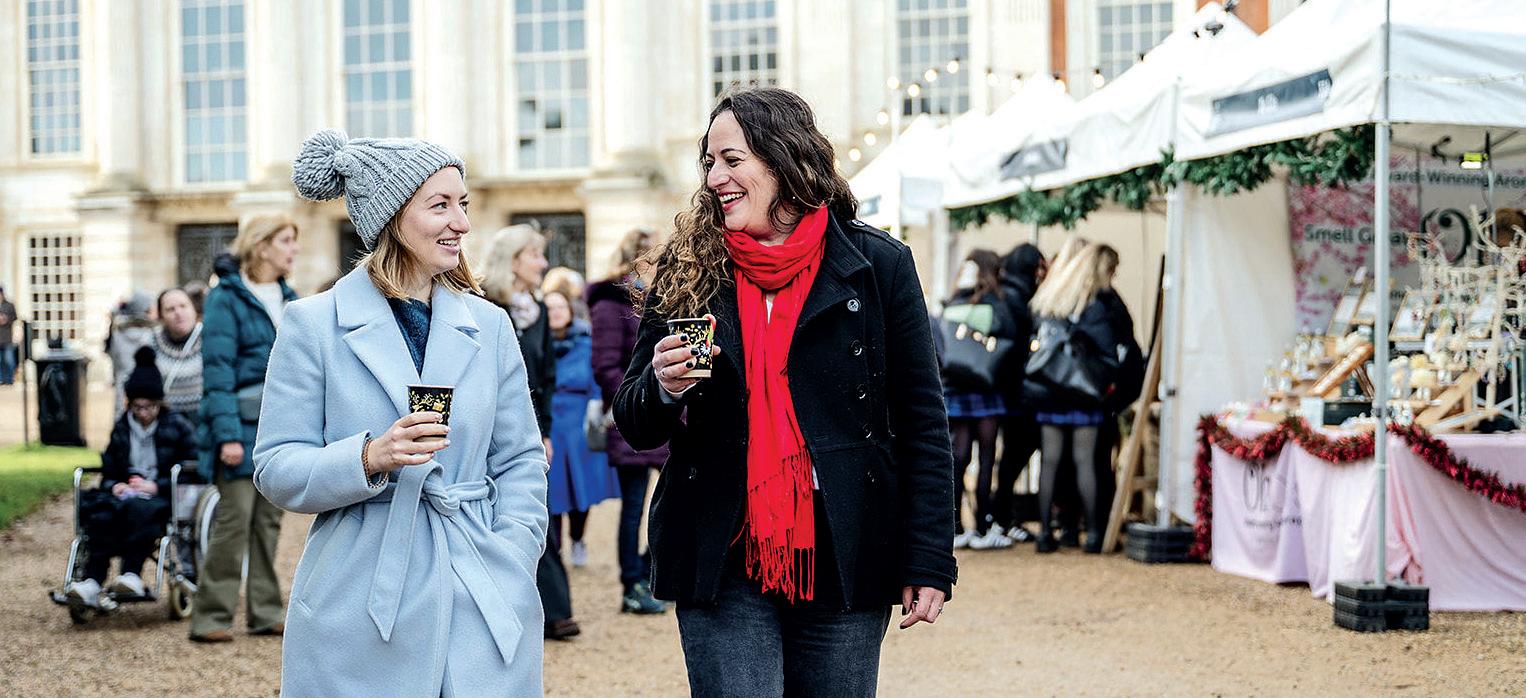
HAMPTON COURT PALACE
Dare to explore Henry VIII's notoriously haunted palace this Halloween, 25 October – 02 November – the spookiest time of the year at the palace?
Brave our brand-new eerie outdoor trail, get swept away by spine-tingling storytelling workshops and watch out for restless spirits roaming the historic corridors and courtyards. Pre-booking recommended.
The Festive Fayre returns for two unforgettable weekends, 05-07 and 12-14 December,
TOWER OF LONDON

Last chance to see ‘The Tower Remembers’, a special commemorative display of ceramic poppies marking the 80th anniversary of the end of the Second World War; until 11 November.
hosted entirely in the stunning Great Fountain Garden. Browse over a hundred independent artisan stalls and discover unique gifts, enjoy festive tunes from the bandstand, and savour a variety of delicious street food. Pre-booking required.
Over the Christmas period, 20 December – 04 January, seasonal music will be performed live throughout the day across the palace. In Henry VIII’s kitchens, learn about all things Tudor food related with our historic cooks, including the history of food and feasting at this special time of year.
Christmas is a time for stories and storytelling. Experience A Storybook Adventure, 28 November – 04 January. Explore festive installations and uncover real-life tales of romance, royal processions and castle building.
Be part of an ancient tradition by attending one of our members-only opportunities to witness the Ceremony of the Keys, held nightly for over 700 years. Separate ticket (pre-booking required).
Join a Yeoman Warder tour to hear tales of intrigue, imprisonment, execution and more.
Halloween at Hampton Court Palace 25 October –02 November
Flight, Camera, Action! Live performances at the Tower of London 25 October –02 November
‘The Tower Remembers’ Until 11 November
‘Dress Codes’ at Kensington Palace Until 30 November
Ice Skating at Hampton Court Palace 21 November – 04 January Get discounted tickets, excluding Christmas Day using code HRPMEM25
A Storybook Adventure at the Tower of London 28 November –04 January
Victoria’s Seaside Christmas at Kensington Palace 03 December –04 January
Festive Fayre at Hampton Court Palace 05-07 and 12-14 December
Christmas at Hampton Court Palace 20 December –04 January (excluding 24-26 December)
The Spirit of Christmas at the Tower of London (live performances) 27-31 December
Beano Mischief at the Tower of London 14-22 February
Members’ Preview Day of the new exhibition at Kensington Palace 25 March
Image © Hayley Bray Photography/Immediate/Historic Royal Palaces
© Historic Royal Palaces/ Imperial War Museums
NEWS
Every issue, we bring you the latest developments from across the palaces

A WARM WELCOME ...
... to Henry and Poe, our two new raven chicks at the Tower of London.
Born in April as part of the Tower raven breeding programme, the sibling chicks have been named after Edgar Allan Poe who wrote the famous poem ‘The Raven’ and the many historic Henrys who have lived at the Tower –including Henry VIII of Tudor
fame, and Henry III who built the Wakefield Tower just beyond the raven enclosure.
Henry and Poe join Jubilee, Harris, Poppy, Georgie, Edgar and Chaos at the Tower, where they are cared for by the Ravenmaster Yeoman Warder Barney Chandler, and his team. ‘I’m absolutely delighted with how they’ve settled in so far’ reported the
Ravenmaster. ‘The team and I have had a busy couple of weeks looking after these troublemakers, who require a lot of care and attention when they’re very young, but now that they’re almost fully fledged, we’re ready to bring them into the fold and let the other ravens take over showing them the ropes.’

FUTURE-PROOFING THE GARDENS
Historic Royal Palaces has appointed awardwinning garden designer Ann-Marie Powell to redesign the iconic Great Fountain Garden at Hampton Court Palace to make it more sustainable, climate resilient and biodiverse in the years to come.
The garden currently has 26 individual flower beds, all planted with summer annuals or spring bulbs depending on the season, as well as the long herbaceous border which runs the length of the garden. Together they consume an enormous amount of water, whilst the production of 40,000 bedding plants in our greenhouses each year contributes significantly to our CO₂ emissions. Add to this the twice-yearly
cultivation of the soil, which is detrimental to the soil ecosystem, and the quantities of plastic needed for bedding plant production – and it is time to review and adjust our approach for the future.
Powell will work closely alongside our gardens team to design and implement a new permanent planting scheme featuring more perennials, naturalised bulbs and shrubs to reduce carbon emissions, improve soil health, and enhance biodiversity while creating vibrant garden displays year-round. The planting will be bold, rich and colourful retaining the splendour and impact that the gardens are famous for, while remaining sympathetic to the existing environment and the historical significance of the site. Powell commented:
‘Together, we will honour the garden’s rich history by promoting sustainable gardening practices that ensure it can continue to thrive in the face of future environmental challenges.’
Changes to the gardens are expected to commence in Autumn 2025.
DISCOVER MORE
To find out more about how we’re adapting our historic landscapes to meet the environmental challenges of the future, visit hrp.org.uk/sustainability
Above A computer-generated image of how the new planting will look.
Left Ravenmaster Yeoman Warder Barney Chandler with the fledging ravens.
BURIED TREASURE
Earlier this year, curators at the Tower of London undertook a major archaeological excavation at the Chapel of St Peter ad Vincula, following a trial excavation in 2019. This was necessary for the installation of a new lift, as part of our commitment to make the site more accessible for visitors and is the most important excavation within the Tower for a generation.
The works revealed some tantalising discoveries about the Chapel’s history. The remains of over 20 individuals have been uncovered during the process, which will now be analysed by the University of Cardiff to find out more about
them and their lives at the Tower. Alongside this have been several incredible small finds, including fragments of a burial shroud – which is particularly rare as textiles do not normally survive in these conditions – alongside a single burial containing two late 12th to early 13th-century pots, which are exceptionally rare examples of medieval grave goods only found in England once before.
This is the first major archaeological dig in this part of the Tower of London and has offered an exciting opportunity to revolutionise our understanding of the building and others that stood before it – re-drawing the map of the medieval fortress.
Further assessments and analysis on all the finds will be carried out in the coming year, with the hope of uncovering even more insight into the Tower’s long history.
The Chapel of St Peter ad Vincula will reopen soon; visit for free as a member.
DISCOVER MORE
Visit hrp.org.uk/blog to discover more about recent excavations at the Tower of London.

Below
Curator, Alfred Hawkins (left) showing the site to Historic Royal Palaces’ Chief Executive, John Barnes.

LAST CHANCE TO SEE
The exhibition
‘The Indian Army at the Palace’, which explores the fascinating but forgotten story of the soldiers who camped at Hampton Court Palace in the early 20th century, closes on 04 January 2026 so make sure you don’t miss it.
Soldiers from the Indian Army were invited to join the coronation celebrations of Edward VII (1902), George V (1911) and George VI (1937) as well as the First World War peace parades in 1919.
Through a remarkable collection of objects, photographs, film and
personal stories, the experiences of those within the camps is brought to life as well as the press and public reactions to their presence.
In November we will be running a series of costumed performances around the exhibition. See hrp.org.uk for details.
THE UNCROWNED QUEEN

A very rare oil portrait of Caroline of Brunswick as queen has recently been acquired for our permanent collections.
Princess Caroline of Brunswick married George, Prince of Wales (later King George IV) in 1795 but it was a
very short and unhappy union and just over a year later they were living separate lives, with Caroline taking up residence at Kensington Palace from 1808 to 1814. By the time she became queen in 1820, her husband was attempting to divorce her on the grounds of adultery and strip her of her royal privileges. Consequently, oil portraits of her as consort are very few in number, making this an exciting acquisition for us.
In both its symbolism and scale, the portrait attempts to assert Caroline’s royal status at a time when her position was under serious threat. She is shown with a crown, even though she was barred from George IV’s coronation and denied her crowning
moment. She is seated in a chair of state beneath classical draperies, holding a paper and wearing several ruby rings. The building in the background is Brandenburgh House, Hammersmith, where Caroline lived from 1820 until her death there in 1821, having been denied a royal residence. The large scale of this painting (130 x 154cm) suggests that it was painted to satisfy demand at this time, when Caroline the ‘injured queen’ was at the peak of her popularity from 1820 to 1821.
The painting is destined for future display at Kensington Palace.
Above: Queen Caroline, by or after Abraham Wivell, c1820.
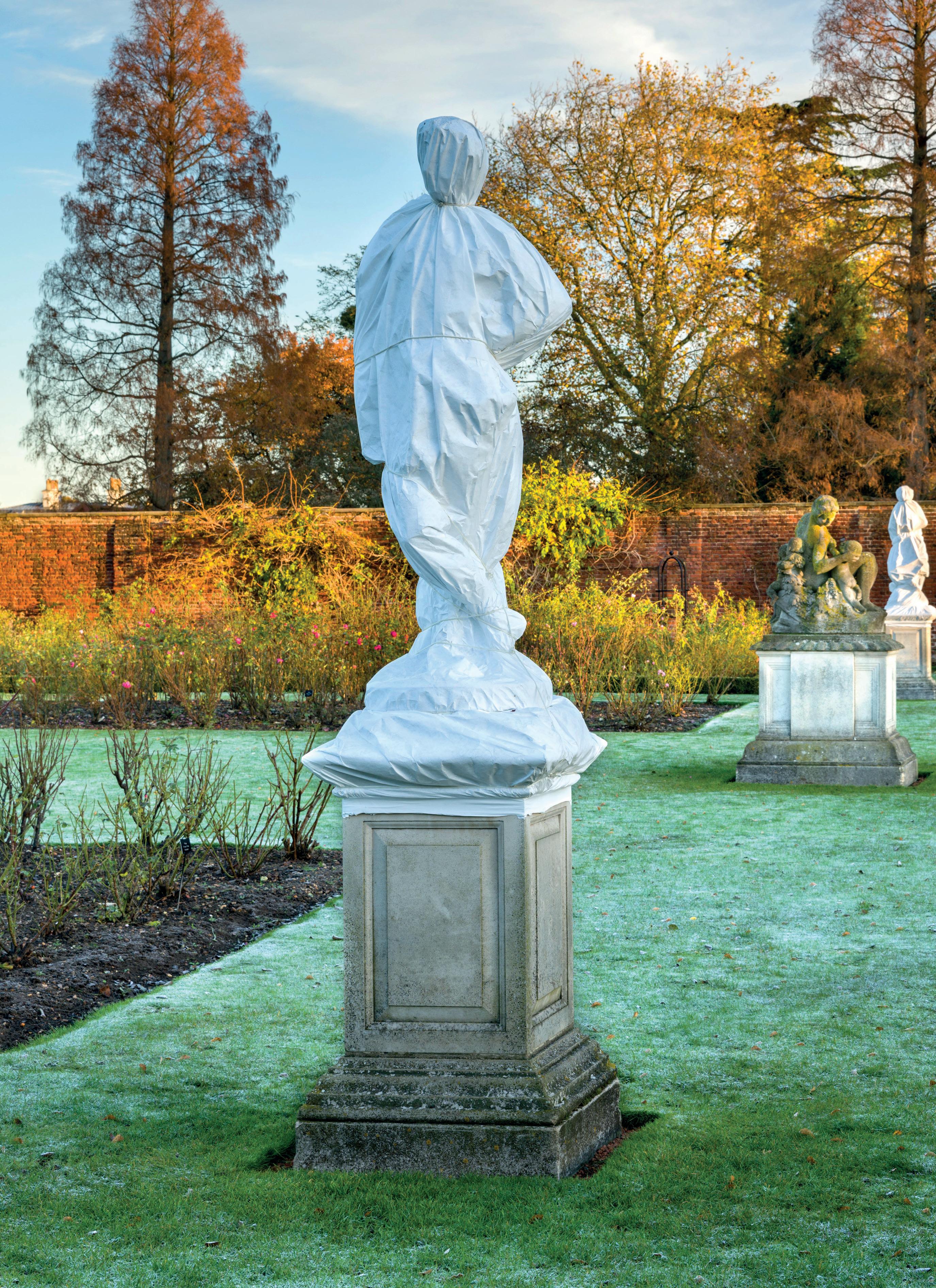
STONE LOVE

Every autumn our garden statues at Hampton Court Palace are carefully cloaked in dramatic winter costumes.
Preventive Conservation Manager Kerren Harris explains why.
While you are out and about in the palace gardens this autumn, you will notice that our statues are being given their annual ‘wrap’ to protect them from the worst elements of winter weather. This seasonal ritual has been taking place for several years and forms part of our ongoing conservation maintenance programme.
The protective covers are made of Tyvek® and are designed to keep the statues dry, rather than warm. Tyvek® is a nonwoven synthetic material that acts as a water-repellent, yet breathable, membrane – in other words it allows water vapour to pass through it but does not allow liquid water to spread through its fibres or wet its surface. So, any build-up of moisture under the covers is allowed to dissipate, but rainwater remains as droplets on the surface of the Tyvek® and does not wet the stone underneath.
Why do we go to such lengths to keep the statues dry? Droplets of rainwater sit on the surface of the marble and penetrate its pores. If the temperature drops and the water freezes, the ice formed can cause the stone to fissure and crack, especially in fragile and vulnerable areas, such as those already eroded by wind and weather.
The scenario is not unlike a frozen domestic pipe, but on a microscopic scale! If there are several freeze/thaw cycles the damage can be significant as each time the cracks will get larger and deeper and eventually small fragments of marble can cleave off.
You may also notice that we do not wrap all the statues in our gardens. A potential downside of wrapping the statues in Tyvek® is that the microclimate created may encourage biological growth (algae and lichen) on the object’s surface, which can be difficult to remove and can leave marks. This growth can happen naturally on external statuary over the years, but it is possible that the Tyvek® covers are exacerbating the problem. Because of this, we avoid wrapping any of the statues that are particularly vulnerable to this biological growth.
When we remove the covers in March, this is also our opportunity to take a closer look at each of the statues –we record any condition changes that may have taken place over the past 12 months and surface clean each statue so that they are all looking their best for the summer season ahead!
HELP THE GARDENS WEATHER IT ALL
Historic Royal Palaces is an independent charity. With Gift Aid, your membership can go even further to help protect Hampton Court’s gardens for future generations. If you’re a UK taxpayer, we can claim an extra 25p for every £1 of your membership donation, at no additional cost to you If you haven’t already opted into the scheme, please email us at members@hrp.org.uk
Left
The Rose Garden at Hampton Court Palace, where vulnerable statues are wrapped to protect them from the winter frosts.

‘ I FIRST JOINED HISTORIC ROYAL PALACES FOR THE STORIES, THE NEXT TIME, FOR THE PEOPLE.’
DISCOVER MORE
Watch our video ‘The Extraordinary Art of Tudor Embroidery’ on our YouTube channel Historic Royal Palaces.

THANK YOU
The palaces are the settings for the stories that shape us all. Your support means that everyone can find themselves in the spaces and stories we share. Find out more at hrp.org.uk/ about-us
Inside Story catches up with Chief Curator Eleri Lynn just a few months into her new role.
Eleri is quick to express her delight in returning to the ‘magical sites’ and ‘incredible teams’ at the palaces, where she worked as Curator of the Royal Ceremonial Dress Collection from 2013 to 2021. Eleri took up the role of Chief Curator in February 2025, when Lucy Worsley stepped down after 21 years, and is now adapting to a different role. ‘Tracy [Borman] whose role has now been reframed as Chief Historian, continues to head up our public history side with lots of filming, broadcasting and podcasting. My team of 30-plus curators is brilliant at articulating all the wonderful work we do through social media – many are now gaining new young followers on Historic Royal Palaces TikTok for example – so I’m free to work more behind the scenes, ensuring that our research is happening in a constructive way, exploring inclusive histories, working with colleagues to make our collections more relevant and accessible not just to those who visit the palaces.’
Historic Royal Palaces’ ambition to be a charity for everyone is one of the reasons that drew Eleri back from her previous role as Head of Exhibitions and International Touring for National Museum Wales, a place she loved as a child and that inspired in her a passion for history. ‘I grew up in the South Wales Valleys in the 1980s, when industry was closing down, our communities were fragmenting, but I remember that wonderful museum as a beacon of culture, art and connection to the past.’
Her fascination with fashion and textiles – and the power of dress – developed when she joined the Victoria & Albert Museum in 2003 as an Assistant Curator where, serendipitously, she was assigned a role in the Textiles and Fashion department and spent the next ten years absorbing and learning. With hundreds
of hours exposed to a massive variety of historic garments and fabrics, Eleri built up a mental database. ‘It was absolutely the best preparation to be able to recognise something extraordinary when it turns up’. That happened in 2015 when she identified the Bacton Altar Cloth, a piece of fabric discovered in a Herefordshire church, and which subsequent research suggested may have come from a dress worn by Elizabeth I.
For Eleri, the Tudor Queen comes top of the bill when it comes to power dressing. ‘Elizabeth was the first queen to use dress in sumptuous fabrics to create a whole mythology around her. The way she used whalebone farthingales in her skirt, huge sleeves, enormous ruffs to make herself seem larger than life.’ When asked whose fashion sense she admires today, Eleri mentions The Princess of Wales (‘a master class in dressing up, and down, for every royal occasion’) and surprisingly, Beyoncé (‘such bold, powerful statements on stage’). However, she also admires those who challenge stereotypes to express themselves and push boundaries.
‘I think my most exciting fashion moment was seeing Billy Porter at the 2020 Academy Awards, wearing that incredible gown inspired by motifs at Kensington Palace. I showed its designer Giles Deacon around the palace the previous year, so it was a real thrill to see what he created for Billy.’
During her career Eleri has gained a wealth of experience. ‘It’s funny, but it seems like every job I have done has contributed to this role; I now feel I have experience in every aspect of the work of my interdisciplinary team, which covers collections, buildings, archaeology, research, teaching and mentoring. So, although I don’t know all the answers, I hope I can ask the right questions!’
Explore more with Eleri Lynn in a new video created especially for our members – coming soon to hrp.org.uk/the-vault

With Yeoman Warders’ pub The Keys the last pub standing, Curator Alfred Hawkins calls time on a centuries-long tradition of taverns at the Tower.
TOWER TAVERNS
Pubs and taverns hold special significance as centres of local communities, meeting places, and often as historic spaces. Just the word ‘pub?’ can be a question, answer, celebration or consolation.
When we think of the Tower of London though, we don’t often think of jolly pubs, but rather the tall tales of treason, torture and execution that tend to define our understanding of the forbidding fortress. There is, however, another story that runs in tandem with the more dramatic moments in history – the fortress as a place of community.

Right Yeoman Warders enjoying a drink in their social club in 1947.

There have always been people living within the castle’s walls, though the composition of that group has changed over time. Historically, it included individuals from the different institutions of the Tower: the Royal Household, Royal Mint, Board of Ordnance, Wardrobe, Menagerie, Garrison, along with craftspeople and others. Today, the community is largely formed of the Yeoman Warders, Officers of the Tower, and other Historic Royal Palaces staff.
Particular buildings at the Tower have been associated with these groups; for example, the Chapel of St Peter ad Vincula, the site’s parish church, or the Waterloo Barracks, a garrison building-cum-office space and home of the Crown Jewels. But in the grand British tradition, all of the groups shared a requirement for a pub within the walls!
As members, some of you may be familiar with our current hostelry, The Keys, operated by the Yeoman Warders, which serves as the Tower residents’ private pub. But you may not have realised that The Keys is just the latest in a long line of pubs, bars and taverns within the fortress.
One of the earliest pubs is thought to have been The Bunch of Grapes Tavern, believed to have been medieval in origin, located to the south of the Bell Tower and demolished in 1796. Other pubs include The Tiger Tavern, located outside the walls on Tower Approach, which may date to the early 1500s. Aside from the name, this pub clearly took advantage of the draw of the Menagerie, and by the 18th century held its own collection of exotic birds! This pub went through several rebuilds before being demolished in 2002. →
HISTORY AND STORIES

A mysterious pub is also mentioned in 1597 by Sir John Peyton, Lieutenant of the Tower, who complains of enduring ‘a Comon Brewhouse … within ye mint’, suggesting that a Tudor pub was being kept within the Outer Ward.
Later pubs and taverns are easier to trace, particularly from 1681/2 when various ‘Sutler’s Houf[s]es’ are noted across the Tower, notably over gates in the western and eastern casemates which barred access to the Mint, and to the north of what is now The Keys pub. Sutlers, also known as victuallers, were individuals who sold provisions to the army. Sutlers were often licensed to sell alcohol but were also often involved in more nefarious activities such as gambling and prostitution. With hundreds of men stationed at or living within the Tower at this time, we can only imagine the steamy atmosphere within these Sutlers’ houses.
After 1681 we can begin to find more detail about the use of these pubs. By at least 1700 the Sutler’s house at the end of the western casemates became known as The Stone Kitchen. This pub was clearly a favoured haunt of some Yeoman Warders – as shown by the discovery of a pewter tankard during excavation in the moat during the 1990s. This tankard, which dates from the 18th century, is engraved with ‘F Dobson, Stone Kitchen Tower’ and the initials ‘DFS’ are marked on the thumb rest. Records show that Francis Dobson became a Yeoman Warder in 1791 and must have frequented The Stone Kitchen tavern to have his own tankard on hold within the pub – how it ended up in the moat though, we can only guess! Later, in 1844, following an official visit, the King of Saxony enjoyed a bowl of punch with the Yeoman Warders in The Stone Kitchen! Alongside this pub was The Golden Chain, located to the north of what would become The Keys. This building is thought to have earlier origins but is likely an evolution of the ‘Sutler’s Houf[s]e to the west, demolished before 1777.
These taverns lasted up until 1846 when The Stone Kitchen, Golden Chain, and other pubs were demolished under the orders of the Duke of Wellington, who was no doubt dismayed by the scale of drinking at the Tower. These popular pubs were replaced with ‘dry’ canteens in the Main Guard (southwest of the White Tower) and elsewhere. This was part of sweeping changes to the organisation of the fortress, intended to professionalise the operation of both the garrison and the Tower at large.

Above
The Stone Kitchen tavern served many generations of the Tower's community. This watercolour by Thomas Hosmer Shepherd was made in 1826.
Right
This pewter tankard from the late 18th century was excavated near the site of the Stone Kitchen tavern, It belonged to Yeoman Warder Francis Dobson and is inscribed with both his initials and the name of the tavern.
But it had devastating consequences for those who operated the pubs, one of whom took his own life in despair, as reported in the West Kent Guardian, Saturday 5 December 1846:
Up to a few months since, three public-houses were licensed in the Tower, one of which, namely, the Stone Kitchen, which is as ancient as the time Henry VIII., was occupied by Mr. Lund, yeoman warder of the fortress. Another victualler, licensed for the Tower, named Sutcliffe, also received notice under the new regulations, that his house, called the Golden-chain, close to the Iron gate, must also be done away with on the opening of the new canteen. As both these parties were more or less under the influence of the authorities of the Tower, they quietly succumbed to the new regulations, though at an immense sacrifice.
The deceased, George Tidy, who was also a licensed victualler the Tower, but not at all responsible to any of the authorities, resisted the order up the last; and, imagining that his length of holding gave him a prescriptive right, such as any citizen would enjoy in any locality where he had expended his whole capital in establishing his trade, refused to obey the injunction. Finding, however, that the order was imperative, and fearing to meet the consequences, which he felt must be ruinous in any way, at 4 o’clock on Sunday last, after having exhibited for some time symptoms of great mental distress, and frequently said he would never be taken out of the house alive, he cut his throat in his bedroom, inflicting a most frightful gash. Application was made to the nearest surgeon; but life was quite extinct, and all hope of reanimation abandoned.

As time moved on though, bars and pubs began to re-emerge within the fortress. The building that would become The Keys was built in the late 19th century and by 1912 was being used as armourers’ workshop, store, and residence, while a separate unnamed bar was located in the northern casemates. Following the Second World War, during which the soldiers’ ‘dry’ canteen in the Main Guard was destroyed by an incendiary bomb, this structure was finally refurbished to become The Keys, the sole survivor of the many pubs within the Tower.
In 1844, the King of Saxony enjoyed a bowl of punch with the Yeoman Warders!
DISCOVER MORE
Though entry to The Keys is restricted to residents of the Tower and their guests, members can enjoy a sneak peek online with former Chief Yeoman Warder, Rob Fuller. Visit your digital hub: hrp.org.uk/the-vault
Above Yeoman Warder Nev Dednum behind the bar in The Keys.

ON THIS DAY…
9 DECEMBER 1698
THE BANQUETING HOUSE OPENS AS A CHAPEL
Within weeks of the devastating fire that virtually destroyed Whitehall Palace in 1698, the decision was made to convert the Banqueting House into a chapel. Sir Christopher Wren rapidly fitted out the main hall, completing the work in time for William III to attend a service there on Christmas Day 1698. Wren effectively divided the hall into two by erecting a tall reredos (screen) one third of the way down its length.
Both William III and Queen Anne used the chapel as their principal place of worship.
The small area behind the reredos became the antechapel, while the remainder became the chapel proper. An organ and a pulpit were installed with pews facing one another across a central aisle. Both William III and his successor Queen Anne used the chapel as their principal place of worship, until Anne moved the headquarters of the Chapel Royal to St James’s Palace. The Banqueting House was instead used for preaching and for the large-scale public ceremony of distributing the Royal Maundy at which food for the poor was distributed and shoes and stockings were handed out. Later, this rather complicated ceremony was simplified, and recipients of Maundy were given silver coins in a little purse, as they are today. By 1809, the building had become a military chapel, and major changes were made to accommodate up to 2,000 soldiers, including the addition of a second gallery by the architect James Wyatt. Refitted in the 1830s, the chapel returned to royal use in the 19th century and William IV and Queen Adelaide attended the reopening. Young Queen Victoria attended services at the chapel with her family but by the end of the century the ageing Victoria rarely used the chapel and in 1890 it was closed. For almost exactly 200 years the Banqueting House had been the principal royal chapel of the kingdom – 40 years longer that it had served its original function as a venue for masques and other court occasions.
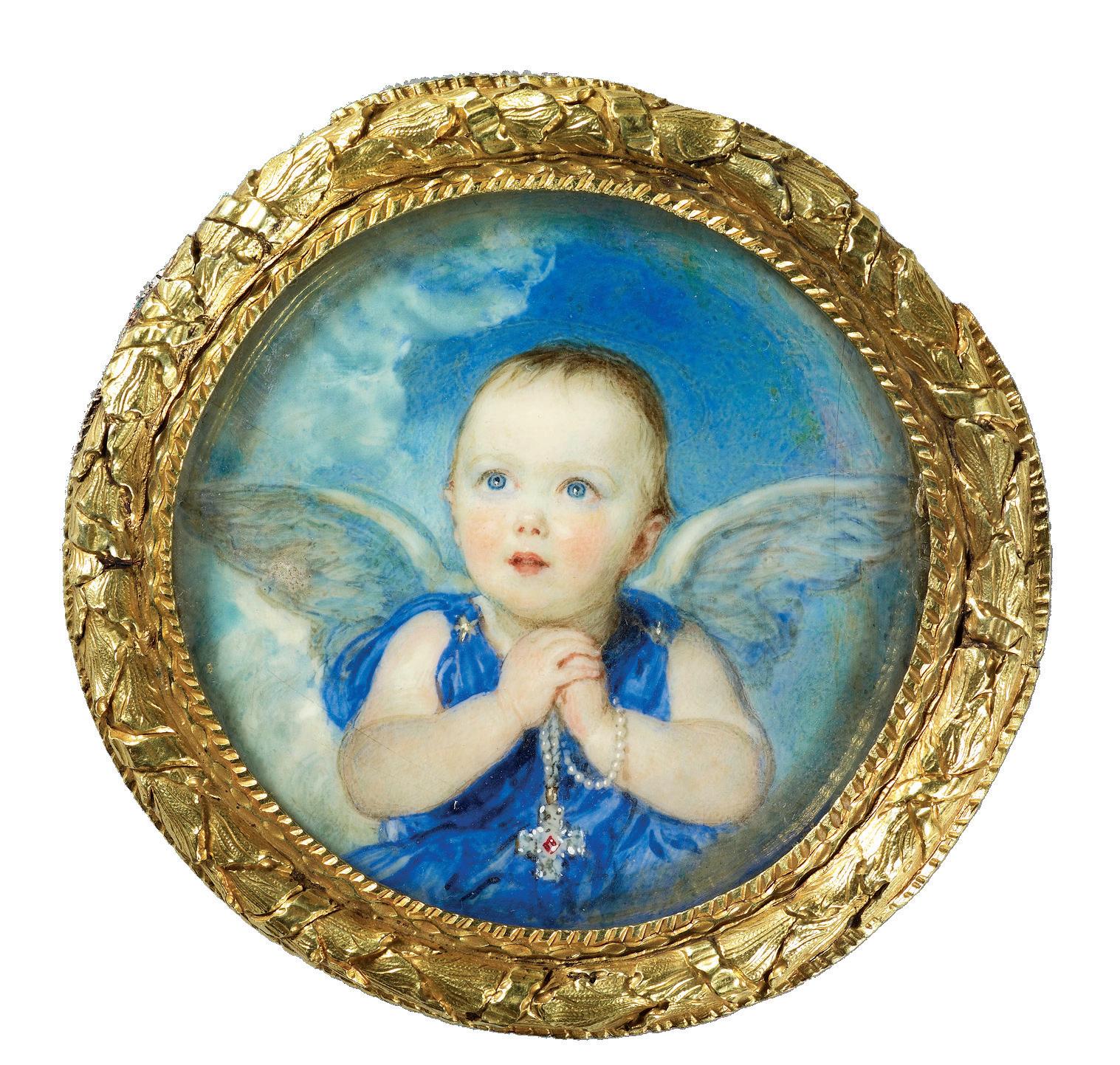
21 NOVEMBER 1840
DISCOVER MORE
On your next visit to the Tower of London, look out for the Lily Font in the Jewel House, commissioned by Queen Victoria for the christening of Princess Victoria. Members go free; no pre-booking required.
QUEEN VICTORIA’S FIRST CHILD IS BORN
Victoria Adelaide Mary Louisa (1840-1901) was the eldest of Queen Victoria and Prince Albert’s nine children. Born at Buckingham Palace, the Queen recorded in her journal: ‘After a good many hours suffering, a perfect little child was born at 2 in the afternoon, but alas! a girl & not a boy, as we both had so hoped & wished for. We were, I am afraid, sadly disappointed, but yet our hearts were full of gratitude, for God having brought me safely through my ordeal, & having such a strong, healthy child.’
coloured engraving, published in 1809 shows the Banqueting House in use as a military chapel.
The Queen soon got over her disappointment and she and Albert doted on their eldest daughter, who became known as Vicky. They made numerous drawings of her (now in the Royal Collection) and commissioned many sentimental mementoes including jewellery containing locks of her hair and plaster casts of her hands and feet. Prince Albert even designed a brooch for the Queen incorporating Princess Vicky’s first milk tooth, which he had pulled out himself – presumably when it was loose!
Collection Enterprises Limited 2025 | Royal Collection Trust

6 JANUARY 1839 THE NIGHT OF THE BIG WIND
SEE FOR FREE
The Night of the Big Wind, known in Irish as Oíche na Gaoithe Móire, was, at the time, the worst storm to hit Ireland for 300 years. The storm raged for 12 hours through a night of ‘indescribable terror’ and daybreak revealed scenes of utter devastation. The Dublin Evening Post wrote: ‘Ireland has been the chief victim of the hurricane – every part of Ireland – every field, every town, every village in Ireland have felt its dire effect. It has been, we repeat it, the most awful calamity with which a people were afflicted’. All over the country, houses were destroyed or damaged. Several hundred thousand trees were levelled and many lost their lives on land and at sea.
At Hillsborough, the household staff battled to save the castle. The 3rd Marquess, who was away at the time, received a letter shortly after: ‘I am very sorry to say that the damage done to your Lordship’s property will I fear prove to [be] a great amount ... about half past eleven o’clock last night it
became so alarming that I found it necessary to call Croziers assistance together with the servants of the house to be up all night going from one apartment to another securing the corridors as many of the which were forced open and a considerable no. of panes of glass broken’.
Over 1,500 trees in the gardens and estate at Hillsborough were lost, including a large willow known as the ‘Kate Rush’ tree. Kate Rush was a young homeless woman who made her living plaiting rushes to make baskets. She also used to follow all the neighbourhood funeral processions to the Old Cromlyn churchyard, which is now part of the gardens at Hillsborough, near the end of Moss Walk. When Kate herself was laid to rest in the 1790s, a young man marked her grave with a stick, which grew into the willow that became known as the Kate Rush tree. After the 1839 storm, several human bones were found tangled in the tree’s roots including ‘3 skulls in a state of great preservation with a part of the hair and teeth in perfect state’.
Visit the Willow House to find out more about the gardens at Hillsborough Castle during the 1830s.
Above
The Big Wind came on unexpectedly at night and many ships at sea, from Limerick to Liverpool, were exposed to the full force of the gales.
© North West Picture Archives/ Alamy
All over the country, houses were destroyed or damaged … and many lost their lives on land and at sea.
14
NOVEMBER 1501
KATHERINE OF ARAGON MARRIES ARTHUR, PRINCE OF WALES
Katherine of Aragon (1485-1536), the youngest child of Queen Isabella of Castile and King Ferdinand of Aragon, was betrothed to Arthur, eldest son of Henry VII and heir to the English throne, when she was just 3 years old, as part of a deal to cement an alliance between England and Spain. Twelve years later, in May 1501, the 15-year-old Princess and her small entourage of ladies travelled across Spain and set sail for England. Within three weeks, she was back in Spain once more, driven back by severe weather. She finally arrived in England in October after another stormy crossing. (‘It was impossible not to be frightened’ wrote one of her ladies.) Katherine and Arthur only met briefly before their wedding at St Paul’s Cathedral on 14 November. Amid much rejoicing and splendour, the bride, dressed in Spanish style with mantilla, her dress encrusted with jewels, was escorted up the aisle by Arthur’s younger brother Prince Henry, then aged 10. Soon after, the teenage newly-weds went to live in Ludlow Castle in Wales where Katherine settled quickly into her new
role as an English princess, wife, and future queen, accompanying Arthur on his duties as Prince of Wales. However, all hopes for this happy arranged marriage turned to dust when Arthur died suddenly on 2 April 1502. They had been married for less than five months. The young widow and her household were trapped in England, in relative poverty, while her father and fatherin-law wrangled over the return of her dowry and who would pay for her household. Katherine even had to pawn some of her jewellery and plate to buy food and clothes and pay for her servants. Despite rumours that 46-yearold Henry VII would marry Katherine himself (and keep her dowry) a more acceptable solution was found by betrothing her to Arthur’s younger brother and now heir to the throne, Prince Henry. Katherine and Henry VIII were married in June 1509, a few weeks after he became king. They were married for 24 years.
SEE FOR FREE

You can still find traces of Katherine of Aragon at Hampton Court Palace today. Look out for her pomegranate emblem carved on to a doorway in the Great Hall and don’t miss this stunning portrait on display in the Wolsey Rooms.
Below Katherine of Aragon, attributed to British School, 16th century. © Royal Collection Enterprises Limited 2025 | Royal Collection Trust



An early, near-fatal illness provoked a succession crisis that continued throughout Elizabeth I’s long reign. But was James VI of Scotland really named by the dying queen?
Chief Historian Tracy Borman reveals the treachery behind the Stuart succession.
THE STOLEN CROWN
On 10 October 1562, Queen Elizabeth I was staying at Hampton Court Palace when she was taken suddenly and dangerously ill with a throat abscess, possibly a symptom of the deadly quinsy. ‘She is in great danger’, the Spanish ambassador reported six days later. ‘If the Queen should die it will be very soon, within a few days at latest.’ Nobody expected her to survive. ‘Last night the palace people were all mourning for her as if she were already dead’, he wrote in another hurried dispatch, adding that Elizabeth was ‘almost gone’. →
Left
An aged Elizabeth I on her deathbed, finally naming her successor … or not?
As vividly imagined by 19th-century artist Paul Delaroche.
COMING SOON
Don’t miss our brand-new video and podcast series exploring the Elizabethan succession –launching this month. You’ll find all the links on your digital hub: hrp.org.uk/ the-vault
The Queen was 29 years old and had reigned for just shy of four years. Her three immediate predecessors had only reigned for 11 years between them. Now it seemed the ill health that dogged the Tudors would claim another victim. Even if Elizabeth recovered, the odds were stacked against her. She was technically illegitimate, her mother Anne Boleyn’s marriage to Henry VIII having been annulled shortly before her execution at the Tower of London in 1536. Added to that, in the eyes of Roman Catholic Europe – and in those of many of her own subjects –the new Queen was a heretic.
Worse still, Elizabeth had no child to inherit the throne if she died. ‘In the end this shall be for me sufficient: that a marble stone shall declare that a queen, having reigned such a time, lived and died a virgin’, she had told the first Parliament of her reign in February 1559. As her life hung in the balance at Hampton Court, there was an urgent meeting of her council to decide who should succeed her if she died. ‘Now all the talk is who is to be her successor’, the Spanish ambassador reported.
The two main contenders were Elizabeth’s closest blood relative Mary, Queen of Scots and Katherine Grey, sister of the ill-fated Lady Jane. The latter’s supporters pointed to the fact that the Scottish Queen was a Catholic and was technically disqualified by the terms of Henry VIII’s will, which stated
This crown is not like to fall to the ground for want of heads that claim to wear it.
very clearly that his Stuart relatives should never inherit the crown of England. Katherine was a Protestant and the legal heir according to Henry’s will, as well as the ‘Device’ for the succession drafted by his son Edward VI on his deathbed in 1553.
As the crisis reached fever pitch, on 23 October news arrived from the Queen’s Privy Chamber. Against all the odds, the Queen survived. But the succession crisis that her illness had brought to the fore would dominate the rest of her long reign. Elizabeth’s determination not to settle the succession gave rise to fierce rivalry between the claimants to the English throne, among them Mary, Queen of Scots and her son James VI; James’s cousin Arbella Stuart; Lady Katherine Grey and her descendants; and Henry Hastings, Earl of Huntingdon. As one contemporary shrewdly observed: ‘This crown is not like to fall to the ground for want of heads that claim to wear it.’
As Elizabeth’s reign wore on, so most of the rival claimants fell by the wayside, either through natural death, disinheritance or execution. By 1603, James VI had apparently emerged as the favourite. His legitimacy, lineage, gender and Protestant religion gave him the edge over his rivals, even if there were still doubts over the legality of his claim. The fact that the King of Scots had two sons also worked in his favour: if he should succeed, the future of the monarchy seemed secure. In ever greater numbers, Elizabeth’s subjects flocked north to ingratiate themselves with the Queen’s likely successor. According to her earliest biographer, William Camden: ‘They adored him as the sun rising, and neglected her as now ready to set.’
It was also Camden who, in his monumental work Annales: The True and Royall History of the Famous Empresse Elizabeth (1615) claimed that almost with her last breath, Elizabeth named James VI as her heir. According
to his account, as the dying Queen’s anxious ministers clustered around her bed at Richmond Palace in March 1603, they urged her one last time to settle the succession. Rousing herself from her stupor, she declared that James should inherit her crown, insisting: ‘I’ll have none but him.’ She died shortly afterwards, and the throne of England passed peacefully to the King of Scots.
But detailed analysis of Camden’s original manuscript published by the British Library in 2023 has revealed that key passages were pasted over and rewritten after Elizabeth’s death to make them more favourable to her successor. Thanks to advances in enhanced imaging, concealed lines could be read for the first time. They suggest that Camden was so concerned not to offend the new King that he rewrote key sections of his manuscript, pasting new pages over his original text.
Among the findings are that Elizabeth’s last-gasp naming of James as her heir was a work of fiction, designed to make his accession appear more predetermined than it had been. The real story of the Elizabethan succession was altogether darker and more turbulent than Camden’s fiction. His original, undoctored manuscript even suggests that James might have plotted to have Elizabeth assassinated.
This staggering new discovery changes everything we thought we knew about the transition from the Tudors to the Stuarts, which for more than 400 years has been traditionally presented as both rightful and peaceful. It inspired my new book, The Stolen Crown, which reveals the real story behind the fiction created by Camden and considers who might have been England’s new king –or queen – if James had not seized the throne by underhand means.
The lie that began James’s reign would have far-reaching consequences. Ignoring Elizabeth’s advice, he stood firmly by the Stuart belief in the Divine Right of Kings, which in his view gave

him the right to ride roughshod over the wishes of his people. His son and successor, Charles I, took this to even greater extremes and dissolved Parliament whenever it refused to carry out his will. By 1642, he had pushed the supremacy of the royal will too far on both sides of the border. The kingdom was plunged into a series of bitterlyfought civil wars which culminated in Charles’s execution outside the Banqueting House, Whitehall, in January 1649. In the space of a generation, the crown that had glittered so brightly on Elizabeth’s head had been consigned to the dust.

Tracy’s new book The Stolen Crown: Treachery, Deceit and the Death of the Tudor Dynasty (Hodder & Stoughton) was published on 4 September 2025.
SAVE MORE
Look out for The Stolen Crown in our gift shops and receive 10% off when you purchase instore with your membership card or use code MEMBER25 online.
Left Modern imaging techniques have finally revealed just how skilfully the Queen’s biographer William Camden pasted new sections, more favourable to the new King, over his existing text.

WARNING
THIS BOOK IS SERIOUSLY SCARY!
The unusual creak of a floorboard, a flash of light in the dark and the eerie breeze from a closed window … We’ve all heard tales of phantoms and spooks haunting the palaces … but are they really ALL in our imagination?
Historic Royal Palaces has been working in partnership with Bloomsbury Publishing on a spooktacular collection of short stories for children aged 9+. From the ghostly phantoms who walk the grounds at the Tower of London to a haunted maze at Hampton Court Palace, the spine-tingling tales in Ghosts in the Walls draw inspiration from palace history to spin some severely spooky stories!
This chilling collection features 11 gripping stories from bestselling, award-winning and rising-star authors including Faridah Àbíké-Íyímídé, Joseph Coelho, Sophie Kirtley and E. L. Norry. The book includes a foreword from Yvette Fielding (Blue Peter and Most Haunted) and an afterword from our Chief Historian, Tracy Borman. Along with beautiful, atmospheric illustrations from Pam Smy, this unique collection is sure to keep readers of every age up long past their bedtimes!
Look out for Ghosts in the Walls in our gift shops and receive 10% off when you purchase instore with your membership card or use code MEMBER25 online.
Above and far right Ghosts in theWalls is full of stunning, atmospheric illustrations by Pam Smy.
© Pam Smy
QUIZ FRIGHT!
The veil is thin, the spirits are restless and it’s time for grown-ups to get down to some spooky business. Test your knowledge on phantom facts and eerie enigmas from our palaces in this fun, members’ exclusive Halloween quiz. Think you know your ghosts from your ghouls?

Q1.
Try these questions for starters and complete the full quiz on your members’ digital hub, The Vault
Q3.
Which animal is said to haunt the Tower of London?
a) A bear b) A raven
c) A lion Q2.
A ‘ghost’ was caught on CCTV at Hampton Court Palace.
a) True
b) False
Dame Sybil Penn, known as the ‘Grey Lady’ said to haunt Hampton Court Palace, served which English monarch as a wet nurse?
a) James I b) Henry VIII
c) Edward VI
HALLOWEEN AT THE PALACES
Hampton Court Palace
25 October – 02 November
Dare to explore Henry VIII’s notoriously haunted palace this October half term – the spookiest time of the year at the palace? Brave our brand-new eerie outdoor trail, get swept away by spine-tingling storytelling workshops and watch out for restless spirits roaming the historic corridors and courtyards. Pre-booking recommended.
Hillsborough Castle and Gardens
25 October – 02 November
Get closer to nature this Halloween at Hillsborough Castle and Gardens. Join a pumpkin carving workshop (pre-booking required), navigate the twisty maze and go on a storytelling walk. Challenge your family to classic Halloween games from conker tournaments to apple bobbing. On 01 and 02 November enjoy traditional Irish music from the Armagh Rhymers.
Scarecrow Parade at Hillsborough Castle and Gardens
04 October – 09 November
WIN!
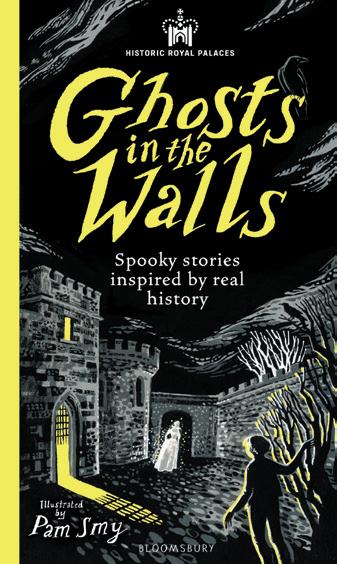
We have 10 copies of Ghosts in the Walls to give away to members. To enter, please email insidestory@ hrp.org.uk by 11 November 2025 and tell us who wrote the foreword for the book. Winners will be chosen at random and notified by email by 01 December 2025. For full terms and conditions, please see hrp.org.uk/ membership/ghosts-competition
See the Walled Garden vividly brought to life with spectacular scarecrows. If you look long enough … you may see them start to move … eeek!

INSPIRING HISTORY
TEACHING AWARDS
TOP
OF THE CLASS!

Do you know an inspiring primary, secondary or special school history teacher?
We want to hear about them! Lucie Parkes, Historic Royal Palaces’ Deputy Head of Schools reveals our exciting new awards scheme that needs your nominations now.

As a member of Historic Royal Palaces, you will already appreciate, as author Michael Crichton so elegantly puts it (right), why history matters. Perhaps you had a teacher who sparked your interest as a child, someone who captured your imagination through vivid storytelling, who made history accessible and relevant to your life.
A great teacher can ignite a love and appreciation of history. They create excitement and inspire creativity by

telling a good story from the past. And beyond that, they can encourage us to ask questions and be curious – a vital skill in the age of social media and AI.
History teaching matters!
Surprisingly, the importance of inspiring school age children to learn, explore and most of all enjoy history is not always obvious. The number of young people opting to study history at university has been declining in recent years, although the future looks brighter, as the numbers opting →
If you don’t know
history,
then you don’t know anything. You are a leaf that doesn’t know it is part of a tree.
Michael Crichton
DISCOVER
MORE
Explore new videos and learning resources at hrp.org.uk/ schools, as well as details of special Home Educator days at our palaces.
to take the subject at GCSE are on the rise, proof of the wonderful history teaching going on in our schools.* History is still a popular subject, but currently UK schools face huge challenges in recruiting and retaining qualified teachers. So, we feel the need to remind our teachers just how important they are and how much we appreciate what they do.
That’s why this autumn Historic Royal Palaces is launching the first ever Inspiring History Teaching Awards to find the UK’s most inspirational and innovative history teachers, whether from primary, secondary or a special school. We believe the unique talents that history teachers bring to their subject, along with the responsibility they bear, needs to be recognised and celebrated. We want to encourage and motivate those that are pioneering new and creative ways to engage all children to make personal connections and to feel history’s relevance to their lives.
Why Historic Royal Palaces matters!
The magnificent palaces in our care, and all their human stories are a wonderful resource for inspiring history, sparking curiosity and finding that personal and emotional connection. We know visits to our sites can capture young
The biggest challenge facing the great teachers and communicators of history is not to teach history itself, nor even the lessons of history, but why history matters. Stephen Fry
imaginations and excite a lifelong passion for exploring the past. You may be one of the many Inside Story readers who discovered their love of history on a school trip.
While we offer extensive school projects and programmes, online resources and educational experiences for children and young people, we want to do more. We can play a key part in supporting high quality history teaching through the sharing of our expertise, teacher training programmes and through our reciprocal relationships with teachers, supporting them to bring this subject alive inside and outside their classrooms.
We are working in partnership to deliver these awards with the Historical Association, National Museums NI and Royal Collection Trust Scotland, among others, to truly capture the best of the inspiring teaching that is happening across the UK – and will hopefully celebrate and inspire more of it in future years.
How will the awards be judged?
We have established regional and national panels made up of a diverse range of judges from UK-wide school, heritage and cultural sectors. These include a panel each from Scotland, Wales and Northern Ireland and seven others representing different regions of England. Each panel will choose a winner from their area’s nominations.
All ten regional and national winners will be judged by a high-profile panel led by Lucy Worsley and other well-known public historians, as well as established leaders and pioneers within the history education sector.
Finalists will be invited to an awards ceremony at the Tower of London in June 2026, where one outstanding overall winner will be announced.
The overall winner will receive a cash prize and a Historic Royal Palaces life membership, as well as benefits for their schools. They will also become a Teacher Champion, with opportunities to take part in special teacher network events, curate a page on the Historic Royal Palaces’ learning website and to lead teacher training. Regional winners will receive a cash prize and a Historic Royal Palaces membership for one year.
WE ARE LOOKING FOR TEACHERS WHO:
use creative and innovative approaches to bring the past to life
make history accessible and relevant for all students encourage skills of historical enquiry and investigation
explore diverse histories and less-known stories in engaging ways
use historical sources and sites effectively, to enrich learning increase engagement with history in their school’s community
NOMINATE A TEACHER NOW!
Anyone, can nominate a teacher working in the UK, wherever you live now and no matter how long ago you went to school.**
All teachers are eligible (primary, secondary, special school) so long as they are currently teaching history in schools. You can nominate more than one teacher.
The process is simple, just visit hrp.org.uk and follow instructions to nominate. It shouldn’t take longer than ten minutes.
All nominated teachers will be contacted and asked whether they accept the nomination and to provide evidence of their dynamic practice in action. Winners will be selected from the evidence submitted.
Send in your nominations between 21 October 2025 and 14 January 2026.
*Statistics from the Royal Historical Society ** Under 18s need an adult’s permission to complete a nomination
DISCOVER MORE
Look out for updates and meet the winner of the InspiringHistory TeachingAwards in future issues of InsideStory


IN RETROS

In May, Historic Royal Palaces commissioned Poet Laureate Simon Armitage to write a poem to mark 80 years since the end of the Second World War, as part of ‘The Tower Remembers’ installation. Inside Story asked about his inspiration and the enduring power of poetry.

PECT
Inside Story (IS): How did ‘In Retrospect’ begin to take shape?
Simon Armitage (SA): We talked a lot about where the poem would be displayed, the dialogue it would set up with the poppies’ installation. Also, I wanted it to have a life of its own, to be a work of art that would live on after the event. Then it was about trying to find a way into the subject. Commemoration and elegy appear so often in poetry that it’s often quite difficult to meet those subjects head on. Contemporary poetry seems to me to be about detail – trying to find the universal in the particular – so I just decided in the end to focus on the flower itself. I began by writing a sort of ‘field note’ about poppies, describing their qualities and attributes. As a flower it’s so flimsy and frail; how can it cope with what we ask it to represent? Then at the end I try to turn it around so it’s asking us to do the heavy lifting of recollection. I arranged it as two sonnets, and I was also thinking of both VE day, and VJ day, so there is a sort of duality about it.

IS: As a title, what is the significance of your choice of ‘retrospect’ and not ‘remembrance’?
SA: I was trying to hint at the idea of ‘remembering remembering’ rather than just a poem about memory, so ‘In Retrospect’ suggests stepping back, or a little bit after the fact, maybe in the sense that poppies have become very familiar to us, maybe over familiar as symbols and we don’t really think of them that carefully anymore. I was trying to suggest something a bit more contemplative; a bit more distant.
IS: You once said that, unlike some poets, when you sit down to write you are ‘nowhere near’ a fully-formed first draft, but you just have the ‘big Hollywood words, the obvious ones’, suggested by the theme as building blocks.
SA: Yes that’s absolutely true!
IS: So, apart from ‘poppies’, when we asked you to reflect on remembrance, what other key words sprang to mind as a foundation for the poem?
SA: Good question! I’d need to check my notebook! I suppose words like ‘remembrance’ or a version of it –recollection, memory – were going to make an appearance at some stage, because essentially that’s the subject matter. My words that would have been changed at some stage were those around the description of the poppy itself. And I had a moment of doubt with one of the lines, when I talk about not just the people who were killed, but the people that we killed. In the end I felt strongly that the understanding of loss should extend to those people as well. I added ‘let it be said’ because I think it doesn’t always get mentioned when we’re commemorating all those lost in our wars.
IS: Why did you say ‘it’s the poems that count’ out of all the genres you write in? What does poetry offer in contrast to prose, particularly in the context of our failure, or reluctance, to remember the victims of war when even recent conflicts fade from our minds (and our news feeds)?
Poppies have become very familiar to us, maybe over familiar.
SA: Well, in some ways the form represents the idea. You can’t remember the whole text of a novel, but you can memorise a poem. Somebody once said that it’s the only art form that you can hold intact in your mind, in the way that you can’t hold a symphony, or the complex details of a painting. There’s something about a poem; its size, its rhythms and cadences that appeals to memory. The density of a poem – concentrated use of intense

language and often in a brief format –can hold people’s attention in a world where concentration is supposed to be dwindling …
IS: Stephen Fry observed, rather poetically, that the biggest challenge facing communicators of history is to ‘ignite the first spark, the will o’ the wisp … which lights up one source of history and then another, zig-zagging across the marsh, connecting and linking and writing bright words across the dark face of the present’. How can we ignite a love of poetry in those who feel it doesn’t matter to them?
SA: Well, poetry has proved itself to be unkillable, over thousands of years! It’s not for everybody; poetry is not a ‘front line’ art form like film or music. I think it asks more of the people who engage with it. It requires concentration, both to write it and to read it, and not everybody wants to have that relationship with language. That’s why a project like this really appeals to me, as I’ve always thought that poetry is at its strongest when it is unexpected. So, you put it in a public place, where people can come across it maybe by chance; people who may never have bought a book of poetry in their lives, but if you can make your work engaging and appealing then you are getting through to them.

IS: When you were recently awarded the Freedom of the City of London you spoke of London as a place that ‘feels truly historic yet determinedly futuristic’ – which is a wonderful description of the gleaming glass and steel skyscrapers surrounding the ancient Tower of London. What place does the Tower hold in your imagination? Did you ever visit as a child?
SA: I did! I came with my mum, dad and my sister, maybe when I was about 7 or 8. I have a vague memory of filing slowly past crowns and orbs, and I would love to go back and see the Crown Jewels. I regard the Tower as a
IN RETROSPECT
Simon Armitage
The world asks a great deal of the poppies Insists they carry the wounds of war and shoulder the weight of remembrance. Such flimsy, wavering plants; we painted their flowers the colour of blood and punched dark holes in their heads as if bullets had passed through, then trimmed them with green sprigs of hope. And from deep in the seeds we concocted the essence of sleep and dreams and resting-in-peace. Almost weightless even in full bloom we made them souls, the poppies, souls of those who we lost, and – let it be said –those who we killed.

Poppies – nourished in darkness, nourished by dirt. But for all their spindly roots, frail stalks and papery petals – as easily smudged as a butterfly wing –they joggle into existence again and again, unearthing themselves in fallow fields and railway sidings, on roundabouts, verges and no man’s land, from the brickwork of old chimneys and bridges and cracks in the pavement. They nod and they nag, reminding us not to forget, flagging a red alert as their crumpled petals unfold. So, rightly, the poppies ask a great deal of the world.
place of mystery; it seems to be towers within towers. Before I was involved in this project, I had no idea that people live on site, that there’s a living and working community here. It’s been interesting to penetrate the outer walls and discover the hidden functionality necessary to running a royal palace.
Simon Armitage was talking to Inside Story editor Sarah Kilby
Simon Armitage is a celebrated British poet, playwright, and song-lyricist who was appointed Poet Laureate in 2019. He is currently Professor of Poetry at Leeds University and has written poetry, plays and non-fiction, receiving numerous awards including the Queen’s Gold Medal for Poetry.
SEE FOR FREE
‘The Tower Remembers’, a commemorative display of ceramic poppies marking the 80th anniversary of the end of the Second World War is open until 11 November. Members go free; no prebooking required
CHRISTMAS
WITH QUEEN VICTORIA

With many of our favourite traditions reflecting Queen Victoria’s, it’s tempting to imagine that her own family festivities were always merry and bright. But as Curatorial PhD student Gabrielle Fields reveals, this was not always the case.
Queen Victoria’s long life reflected and, in some cases, shaped the ever-changing 19th century. There were rapid developments of industry, media and manufactory, as well as the more intimate changes within her own family as she matured from child to queen, to mother, grandmother, widow and great-grandmother.
Victoria’s journals always reflected her priorities, and for the Christmas of 1833 her attention was fixed on presents
Victoria’s grandmother, Queen Charlotte, had introduced German Christmas traditions to the Royal Family when she married George III in 1761. Customs that appear across Victoria’s many Christmases (and ones that we might recognise today) are the installation of Christmas trees, and the Berscherung – the giving of presents on Christmas Eve, rather than on Christmas Day. Moreover, both Victoria’s mother and husband were from Coburg, so there was a distinct Germanic flavour to how she celebrated Christmas.
However, despite the strong traditions underpinning the season, Christmas never looked quite the same from one year to the next for Victoria. By use of her journals we can follow Victoria’s Christmas celebrations across her life, from childhood festivities at Kensington Palace in 1833, to her first Christmas as a widow in 1861, and finally to the political turbulence of 1886 as she approached her Golden Jubilee year. →
Right Queen Victoria, Prince Albert and their family gathered round the Christmas tree at Windsor Castle in 1848. © Science
Source / Mary Evans Picture Library
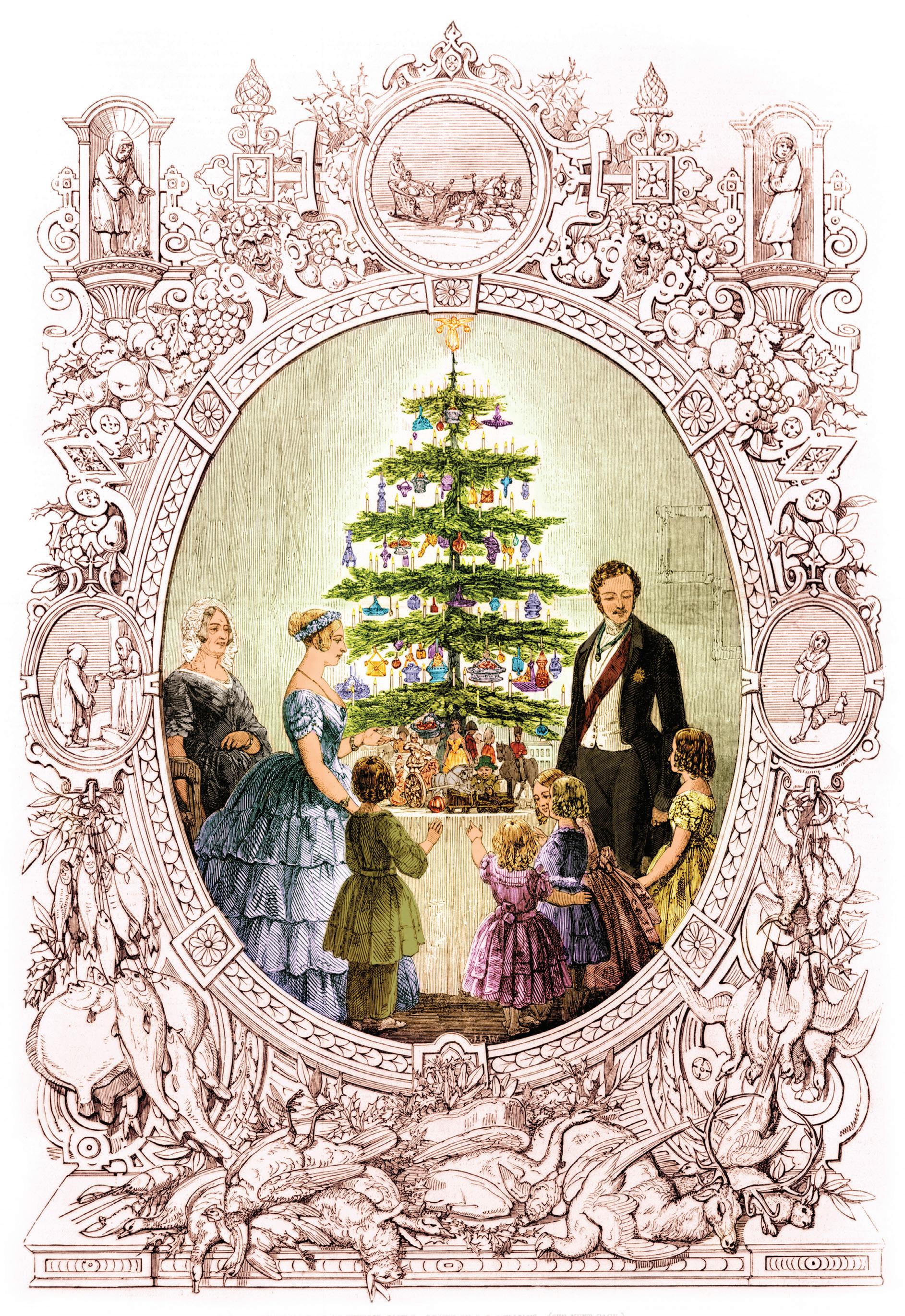
Christmas 1833: Presents for a princess Christmas that year was a windy affair in England, with reports of hurricanes in the days leading up to it in Bath and Arundel. The 14-year-old Princess Victoria was at home, in Kensington Palace. This was the final Christmas that Victoria spent at Kensington, for the years between 1834 and 1836 she stayed at St Leonards, Ramsgate and Claremont respectively, before moving to Buckingham Palace, her new permanent residence as queen after her accession in 1837.

Victoria’s journals always reflected her priorities, and for the Christmas of 1833 her attention was fixed on presents, keeping track of a complex exchange of gift-giving – not only what she received or gave, but also what each member of her family gave to each other.
As was the tradition for all gift-giving in Victoria’s household, including for birthdays, the gifts were arranged in a separate room on tables. In 1833, the Princess received the following items: two combs, a stud, an embroidered cushion, annuals, books, prints, handkerchiefs, a cloak, a blue poplin dress, a pink embroidered dress, an onyx necklace and earrings, a carbuncle brooch, a case and penholder, a pencil case, paper knife, bottles, a paper-holder, a music book, a pencil-top, prints, a small toothpick case ‘made from the mast of Lord Nelson’s ship’ and a workbox. Being the only child in her household, Victoria was very much the subject of devotion from those around her, such as her aunts and teachers, and this is certainly reflected in her list.
But in this long journal entry cataloguing gifts, Victoria saved the best until last – the presents she lavished on her beloved dog, Dash, a 3-year-old King Charles Spaniel given to her earlier that year by Sir John Conroy. The pampered pet received a basin of bread and milk, three rubber balls and two bits of gingerbread – all presented to him ‘surrounded with branches of holly and candles’.
On Christmas Day, Victoria enjoyed the service and sermon given in the chapel at Kensington. She quoted in her journal a line from the bible, as she did most Sundays: ‘And the angel said unto them; Fear not: for behold, I bring you good tidings of great joy, which shall be to all people’.
Right Queen Victoria's Christmas tree at Windsor Castle in 1850 by William Corden the Younger. The Queen describes Christmas Eve 1850 in her journal: ‘My beloved Albert … took me to my tree & table, covered by such numberless gifts, really too much, too magnificent.’
© Royal Collection Enterprises Limited 2025 | Royal Collection Trust
Left
Queen Victoria by John Partridge. This portrait was given to Prince Albert by the Queen at Christmas 1840. © Royal Collection Enterprises Limited 2025 | Royal Collection Trust

Below
This bracelet with a miniature of Prince Albert was given to the Queen by her husband at Christmas 1844. She recorded in her journal: ‘It is his own exquisite taste & one of the loveliest things I ever saw. How I shall value it, & what extreme pleasure it gives. I put it on at once, & it was much admired.’
© Royal Collection Enterprises Limited 2025 | Royal Collection Trust
Christmas 1861: A season of sorrow
Victoria’s marriage to Prince Albert in 1840 resulted in the births of nine children, the first in 1840 (see page 21) and the last in 1857. During these decades, Victoria’s family became the model for middle-class domesticity, and they were beloved by their subjects. The shock, therefore, of Prince Albert’s death on 14 December 1861 was so profoundly felt across the nation that, according to the author Elizabeth Gaskell, ‘no one wishes each other “a merry Xmas” this year’. Albert’s funeral was on 23 December, and the imminent Christmas was a desolate affair.
Albert’s funeral was on 23 December, and the imminent Christmas was a desolate affair.
Throughout her life, even though Victoria didn’t update her journal every day, she made sure that every day had an entry, even retrospectively. The only two weeks in which her diaristic voice fell completely silent were the ones after Prince Albert died. But there are other ways to discover what transpired.
It’s Queen Victoria’s reading, rather than her journal writing, that reveals her innermost thoughts over this period. One aspect of this that I explore in my thesis is how Queen Victoria found solace through books after bereavement. One volume that Victoria and her fellow Victorians valued above most others was Alfred Lord Tennyson’s poem In Memoriam (1850), which he had written as an elegy for his friend Arthur Henry Hallam, who died in 1833. →


We know from other examples of Victoria’s reading practice, as well as the reports from her friend, the Duke of Argyll, that the brokenhearted Queen went through Tennyson’s long poem – divided into 133 cantos (sections) – seeking the parts that resonated with her the most, and annotating the margins, both as reminders to herself and points of connection with others.
Sadly, the copy of In Memoriam containing Victoria’s marginalia is lost, but the Duke of Argyll’s account to the Poet Laureate mentioned specific modifications that the Queen made, similar in style to those she made in other books. She wanted Argyll to relay to Tennyson ‘how well it was read’ and tell him how much she ‘loved to dwell on the poem’.
As requested, loyal Argyll sent Tennyson a letter describing the marginalia, professing that ‘some of them seemed so sacred that except to you I should never speak of them’. One of the annotations that Argyll found especially touching was in Canto XXIX, which opens with this stanza:
With such compelling cause to grieve As daily vexes household peace, And chains regret to his decease, How dare we keep our Christmas-eve; Next to that fourth line about Christmas Eve, Victoria had written ‘we did not keep it in 1861’.
The family had moved down to Osborne House after Albert’s funeral. There were certain aspects of Christmas that were observed, but in a very muted way. The household were still given presents by the family, but the men received black-bordered photographs of the Prince and the women were given lockets with his portrait.
Victoria thought that Christmas would never be an occasion for joy after Albert’s death, and her eldest daughter Vicky similarly wrote the festival ‘never will be happy again’. However, while it would never be as simply joyous and extravagant as before, Victoria was still able to find some comfort in the religiosity and domesticity that Christmas brought.
Above
An elderly Queen Victoria selecting Christmas presents. Illustration by Frederick Pegram (1870-1937). Look and Learn / Peter Jackson Collection / Bridgeman Images
Christmas 1886: Business as usual
In the years following Albert’s death, Victoria continued to spend many of her Christmases at Osborne House, vowing that because Albert had died at Windsor ‘it shall never be spent [there] again’. But in 1886 she returned to Windsor Castle, and this change in location felt ‘quite strange’ to her. By now, Victoria’s immediate family comprised of seven living children and 32 living grandchildren, so correspondence formed a much larger part of these later Christmases.
In 1886, Queen Victoria’s Christmas Eve began the same as any ordinary day –by reading the newspapers. On that particular day, they were full of ‘anger and indignation’ towards Sir Randolph Churchill, the Chancellor of the Exchequer who had just made an awkward political blunder.
On 23 December he attempted a resignation with the hope that the government would concede to his policy to convince him to stay. But instead, it seemed he had overestimated his indispensability. His resignation was accepted, and he was left out in the cold (quite literally – it had been a frosty week).
This, combined with his attempts to cut funding to the Army and Navy, meant that the political business of the day took precedent over any celebration for Queen Victoria’s Christmas Eve in 1886. Before hosting her family for the Bescherung and dinner, Victoria had to entertain a political adviser, Lord Rowton, to manage the situation, and ‘inconvenient though it was’, she did so.
The Bescherung this year took place in the White Drawing Room, and the Christmas tree was lit up for the occasion. She was now the most senior member of the family (both in terms of age and rank). She wrote in her journal about how her ‘very happy’ grandchildren behaved ‘uproariously’ with the toys they received. In between the Berscherung and the family dinner, Victoria had another meeting with Lord Rowton, giving him a note to relay to the Prime Minister. For all the joy she felt from spending the season with her family, she could not help but feel ‘low and anxious’ as the evening progressed – not out of grief, but out of worry for the political upset.
Christmas Day was, as usual in her family, a quieter day. Victoria spent the morning in the beautifully decorated St George’s Chapel and used her proximity to Albert’s Mausoleum in Frogmore to place wreaths of holly. As one busy festive season drew to a close – Victoria having written over 60 cards and dozens of telegrams – another began. The commencement of 1887 brought the beginning of her Golden Jubilee year – which (when compared to her quiet Christmases) was an exuberant affair. After a year of celebrations, Victoria was knocked out with a cold when Christmas came around again.
The Bescherung took place in the White Drawing Room and the Christmas tree was lit up for the occasion.
SEE FOR FREE
Discover
Victoria’s Seaside Christmas, 03 December – 04 January at Kensington Palace and experience the spirit of a Victorian Christmas at the Tower of London through daily live performances 27-31 December. No pre-booking required.
GIFTS GALORE!
Here are just a few ideas to get your Christmas shopping up and running!
Let us inspire you with this selection, all available at your members’ discount. Discover many more gorgeous gifts online at historicroyalpalaces.com

Corgi baby comforter
£12.00
A soft, plush corgi head and crown and corgi pattern make this comforter as cute and cuddly as a Christmas baby!
(And it will get the little one off to sleep soundly, too!)
Measures 25 x 28cm. Matching pyjamas available

Silver and rose gold crown drop charm
£80.00
This little charmer, inspired by the Crown Jewels, is made from sterling silver with intricate details picked out in rose-gold plating. It can be worn on a necklace, or a bracelet.
Sterling silver, rose gold and rhodium platedfor extra brilliance.

2025 London decoration
£20.00
This handmade velvet hanging commemorative decoration, exquisitely embroidered with a gold crown, is sure to bring back happy memories of a visit made this year.
100%velvet, polyesterinnerfilling
Queen Elizabeth II and corgi figures
£28.00
This gorgeous pair of collectible figurines, exclusive to Historic Royal Palaces, will bring a fond smile to many faces as they remember her late Majesty, always elegant, handbag at

Quatrefoil silver and garnet necklace
£140.00
This eye-catching design is inspired by the setting of Anne Boleyn’s Gateway at Hampton Court Palace. The quatrefoil was a symbol of power and harmony at the Tudor court and is said to bring good luck.
Sterling silver, garnets surrounded by whitetopaz stones.
Chain length 55cm. Matching ring also available
Crusader helmet pen pot
£13.00
Do you have a messy medievalist in your life? Or just maybe an untidy history fan who can never find a pen? This perfect pot is made just for them!
Handmade and hand painted resin. Height 11cm. Pens not included
Sweatshirt for a queen
£38.00


The head of your Christmas household will LOVE this navy and metallic gold print sweatshirt. Perfect for a Boxing Day walk, too! Exclusiveto Historic Royal Palaces.
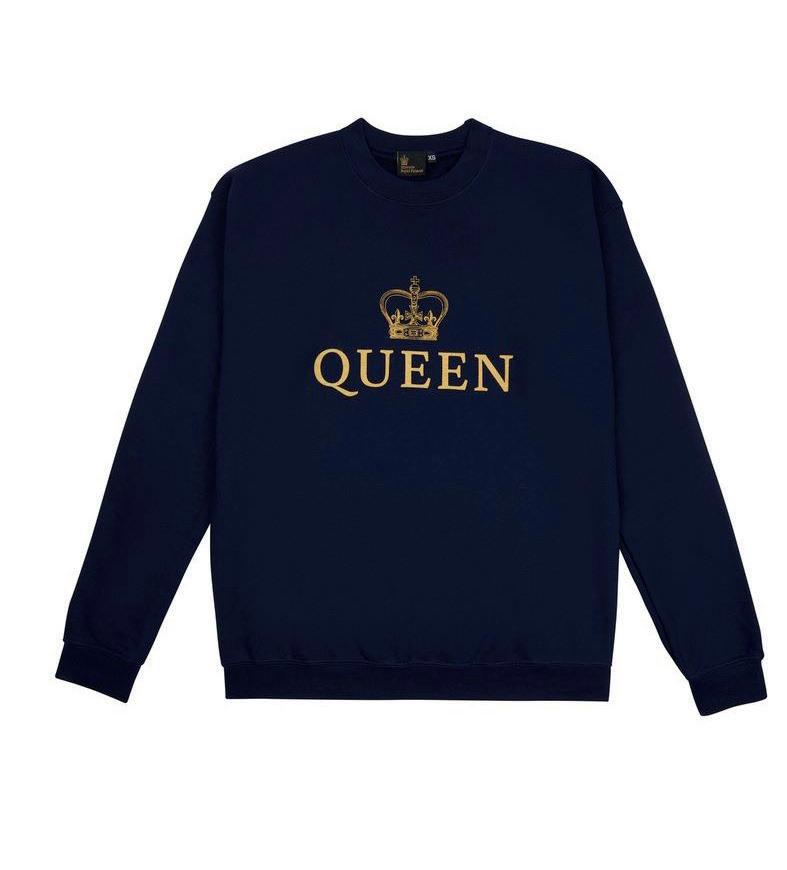
GIFT MEMBERSHIP THIS CHRISTMAS
Give your loved ones a gift they’ll truly treasure this Christmas. A Historic Royal Palaces membership opens the door to a year filled with unforgettable adventures at the UK’s most iconic royal palaces and gardens. From spine-tingling ghost stories at the Tower of London to wandering the maze at Hampton Court, it’s the perfect present for history lovers, explorers and curious minds. They’ll enjoy unlimited entry, exclusive discounts and offers, and access to behind-thescenes events.
Order now at hrp.org.uk/membership/ gift-membership

Murder at the Palace
£20.00
Cosy Christmas? Cosy crime! Neil Daws’s gripping murder mystery is set among the simmering jealousies of the grace-and-favour era at Hampton Court Palace. A must for Whodunnit fans!
Published byOrion in association with Historic Royal Palaces

Tucked away in a small alcove deep within a storeroom at Hampton Court Palace is a very special wall. On it remain fragments of late 17th/early 18th-century wallpaper – rare and especially unusual as it is one of the very few examples still preserved in its original location. Curatorial Assistant, Kate Harris pieces together the story.
The design of the wallpaper may have been based on a contemporary tapestry, an embroidery or a painted cloth hanging.
Shortly after I started working in the Royal Ceremonial Dress Collection stores, I became aware of the wallpaper fragments hidden away behind a protective screen and decided to take a closer look. The pieces were so fragmented that at first glance, any pattern was hard to discern. However, with a great deal of patience and numerous photographs, I used the fragments to create a wallpaper jigsaw. When pieced together and traced, it revealed a captivating historical hunting scene.
WONDER
WALL

Right
Right (inset) Kate Harris used photographs and tracing paper to create a mock-up of the wallpaper design.

Once the mock-up was finished, I was able to carry out some detective work on the finer details of the design. The huntsman’s clothing gave us a clue to the date: the style, length and sleeve shape of the coat is typical of a style worn in the late 17th/early 18th century.
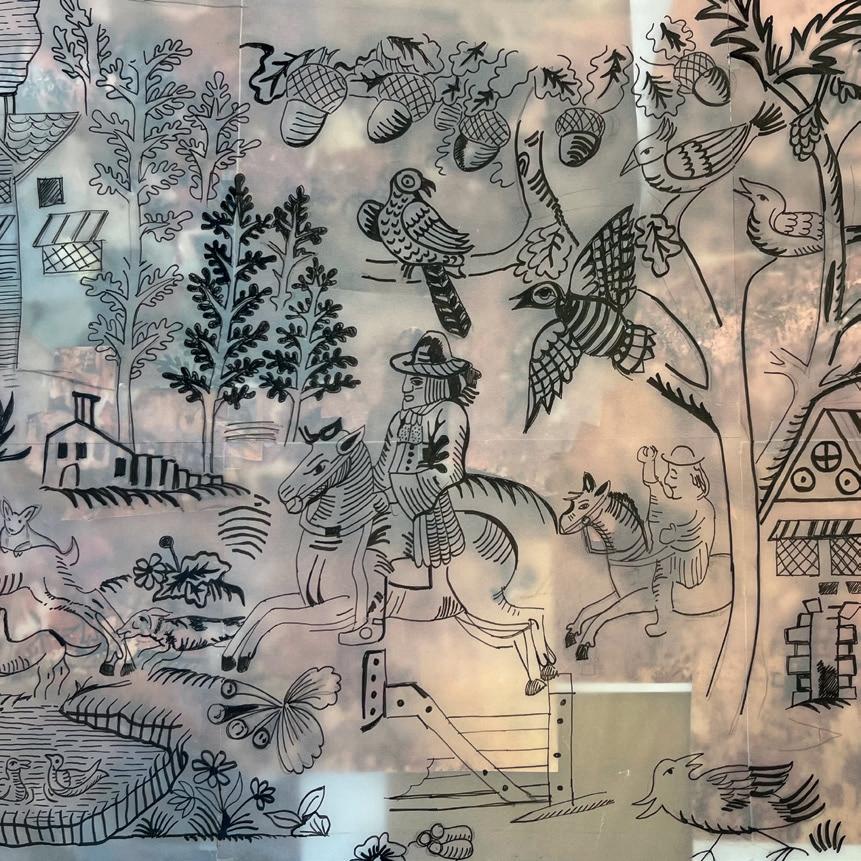
Armed with this suggestion and the mock-up of the design, I visited the Victoria & Albert Museum archives to further my research. Here, I was able to uncover a very similar piece of wallpaper in the Victoria & Albert Museum archives, which had come from Clandon Park House, near Guildford, Surrey, where it had been used to line the inside of a deed box.
Intrigued by our discovery, Gill Saunders, then Senior Curator of Prints at the Victoria & Albert Museum, visited the palace to examine the wallpaper for herself. She confirmed that the fragments date to the late 17th century, possibly early 18th century, and were crafted using a woodcut technique. We were excited to learn that the style and age of the wallpaper was the only example Gill had ever seen on the wall to which it was originally glued!
Gill believes that the wallpaper would have originally featured a white background with the inclusion of stencilled blue and green colours that would have been added after the paper was stuck to the wall. The glue itself would have been a simple mixture of flour and water – which has stubbornly remained (thank goodness!) for over 300 years. →
Below
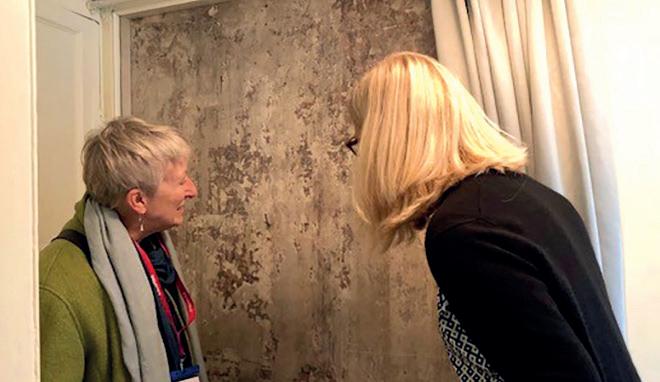
Gill Saunders from the Victoria & Albert Museum examining the wallpaper with Kate Harris.
The woodcut technique used to create the design results in the heavy black lines seen in the pattern, which imitate designs commonly found on textiles, particularly an embroidery stitch from the period known as ‘blackwork’. Research suggests that in the late 17th century, aspirational homeowners unable to afford the luxury of tapestries to decorate their walls would purchase wallpaper as a cheaper alternative.
So, who was the aspirational individual who occupied the room where the fragment is located? Our records suggest that this was a member of the
WALL STORIES
At Hampton Court Palace our wallpaper collection (some in situ and some in our archives) reflects both the decorative trends of the past and the evolution of wallpaper technology, from a very early example of a woodblock-printed paper from the 16th century (when wallpaper was first introduced in Europe) through to 19th-century flock designs in the state rooms and many examples of wall coverings from the grace-and-
Royal Household, Thomas Hardyman, Sergeant of the Scullery and Charcoal House who, with his team of staff, was responsible for looking after hundreds of utensils in the palace kitchens and keeping the kitchen fires burning with a constant supply of fuel.
After a hard shift at work, I like to think of Hardyman relaxing in his room, drink in hand, sitting proudly next to the fire in front of his magnificent wallpaper, keeping half an eye on staff crossing the courtyard outside his window on their way to the kitchens.
Read on to discover how this design has been recreated by our licensing partners GP & J Baker, Wallpaper and Furnishing Fabric specialists, working in collaboration with our inhouse licensing team.
This wallpaper on wood (below) is the earliest fragment in our collection, discovered in a room in Base Court. Dated to 1550-75, the design is typical of the period with its simple repeated pattern based on heraldic motifs. Here, the royal coat of arms is surrounded by vases of flowers with a medallion of St George slaying a dragon above. The coat of arms is surrounded by the French inscription Honi soit qui mal y pense



WE’RE ON A ROLL!
Historic Royal Palaces has been working in partnership with GP & J Baker to create a stunning new fabric and wallpaper collection, including one design taking inspiration from the late 17th/early 18th-century wallpaper fragment featured on the previous page.
Entitled ‘Home Park’ after the historical hunting ground at Hampton Court Palace, the design depicts two men on horseback amongst birds of prey and trees laden with acorns and pinecones. A majestic peacock appears in front of a hunting lodge with smoke billowing from its chimney.
Serendipitously, this design was already part of the Baker archive and had a long history with the company. Then called ‘Park Lane’, it was produced as a block printed linen and as a cotton in 1937, then again after the war, and as a chintz in 1975. It has now been reproduced under licence with Historic Royal Palaces as part of Baker’s ‘Royal Court Collection 2025’, where it is available in a wallpaper of six colourways (left) including the original and on fabric in four colourways on linen, as well as one on velvet.
Historic Royal Palaces has been working with GP & J Baker since 2015 and this is our second collection with them. In addition to ‘Home Park’, the latest collaboration includes several other designs inspired by Hampton Court Palace: ‘Royal Maze’, a striking geometric design inspired by our famous hedge maze; ‘Chimneys’ celebrating the array of different and unique patterns found on the distinctive red brick chimneys of the palace and ‘Court Buttons’, inspired by some of the decorative 18th-century men’s court suits in the Royal Ceremonial Dress Collection.
Available to purchase through GP & J Baker website: gpjbaker.com
BIG
ADVENTURES FOR YOUNG EXPLORERS
From hauntingly good adventures to heartwarming festive experiences, we’ve packed the calendar with unforgettable days out for you.
Discover, learn and make memories together with our top picks for all the family. Check hrp.org.uk for more details, members go free (unless otherwise stated).
OCTOBER
SPOOK-TACULAR SEASON

25 October – 02 November Halloween at Hampton Court Palace
Dare to explore Henry VIII's notoriously haunted palace this Halloween? Brave our brand-new eerie outdoor trail, get swept away by spine-tingling storytelling workshops and watch out for restless spirits.
25 October – 02 November Halloween at Hillsborough Castle and Gardens
Get closer to nature this Halloween. Join a pumpkin carving workshop (pre-booking required), navigate the twisty maze and go on a storytelling walk.
25 October – 02 November Flight, Camera, Action!
Discover what life was like at the Tower shortly after it reopened in 1946, following the end of the Second World War.
Join a reporter who will be investigating some of the remarkable events that
Hillsborough Castle and Gardens
Tower of London
Hampton Court Palace
DISCOVER MORE
Find our full programme of events.
Open
Armoury in Action
Get ready for battle! Join our interactive experience and have a go at shooting arrows, brandishing a sword and firing cannon.
04 October – 09 November Scarecrow Parade

See the Walled Garden brought to life with spectacular scarecrows. If you look long enough … you might see them start to move … eeek!
NOVEMBER
WINTRY WONDERS

Weekends until 20 November
Henry VIII’s kitchens
Ready to learn how to survive the seasons – Tudor style?
Step into Henry VIII’s kitchens during weekends and discover why food preservation was more than just a skill for the Tudors –it was a matter of survival.
21 November – 04 January
Ice Skating at Hampton Court Palace
Get discounted tickets, excluding Christmas Day using code HRPMEM25
DECEMBER
FESTIVE FUN IN FULL SWING!

28 November – 04 January
A Storybook Adventure
This Christmas, explore festive installations around the Tower of London and uncover real-life tales of romance, royal processions and castle building.
29 November – 04 January
The Snowman™ and The Snowdog
Step into a world of festive magic as The Snowman™ and The Snowdog are brought to life in a charming outdoor trail at Hillsborough Castle and Gardens.
TIME
TRAVEL INCOMING!
14-22 February
Beano Mischief at the Tower of London
Join us over February half term, as Dennis and his friends crash into the fortress. Along the way, meet iconic Beano characters as they travel through time. Can you help find all the missing pieces of the time machine so Dennis and his friends can get back home?
BOOK NOW
Pre-booking via your member login is required for select events; look out for the ticket icon. Many events are included in palace admission; some require separate event tickets. See hrp.org.uk and check What’s On for details.
05-07 and 12-14 December
Festive Fayre
The Festive Fayre returns this December for two unforgettable weekends. Browse over a hundred independent artisan stalls, enjoy festive tunes from the bandstand and savour a variety of delicious street food.
20 December – 04 January*
Christmas at Hampton Court Palace
Over the Christmas period, enjoy live seasonal music throughout the day across
the palace. In Henry VIII’s kitchens, fire up your cooking skills and learn about all things Tudor food related with our historic cooks.
*excluding 24-26 December
27-31 December
The Spirit of Christmas
Experience the spirit of a Victorian Christmas at the Tower of London. Meet the Tower postman as he attempts to deliver a last-minute gift and join in a giant game of pass-the-parcel. Daily live performances
NIVEK AMICHUND
CHIEF EXHIBITOR, TOWER OF LONDON
In each issue of Inside Story we put your questions to a member of Historic Royal Palaces’ staff.
Nivek, who joined in 2015, manages the Front-of-House (FOH) team of around 50 wardens (as distinct from Yeoman Warders) and has special responsibility for the display of the Crown Jewels. As his predecessors have done since the 16th century, Nivek reports to the Keeper of the Jewel House, the Tower’s Resident Governor Andrew Jackson. In June 2025, Nivek was awarded the Royal Victorian Medal (Silver) in the King’s Birthday Honours.
What does your job involve?
Obviously, I can’t divulge the details around the care and security of the Crown Jewels, but a recent highlight was helping to prepare for the coronation in 2023. I had the enormous privilege of attending Westminster Abbey to assist with certain aspects of the ceremony. I oversee the management of the Front-ofHouse departments, including
ensuring that the Tower looks its very best, from daily building maintenance to checking the warders’ uniforms are dry cleaned regularly! I make sure that I am visible, too – at least once a day I try to visit the Jewel House to chat with visitors. I also work with colleagues on major projects, most recently the re-presentation of the Jewel House.
What was your career path to this unique role?
I had a non-traditional route into the heritage sector – I started as a gallery assistant at Tate Britain. I wanted to encourage young people to enjoy art, so I co-founded the youth forum Tate Collective, which is still going today. I moved to the National Portrait Gallery as Visitor Services Operations Manager and helped with business coaching for young people from difficult backgrounds. I believe my passion for inclusivity, accessibility and my FOH experience helped when I applied for the role at Historic Royal Palaces.
What aspects of your work do you enjoy most?
After ten years I still believe this is the best job in the world! That might sound a cliché but it’s a huge privilege to spend so much time in the presence of the Crown Jewels, and I’ve learnt so much about them.
I love that they are not only stunning display objects but a working collection. I never get tired of answering the question ‘Are they real’, as it’s a testament to how amazing these objects are close up!
Which is your favourite object in the collection?
Right now, it’s the Cullinan II (also known as the Second Star of Africa) set in the Imperial State Crown. This huge diamond, 317.4 carats, was discovered in South Africa, where I was born, so it has a personal connection. I like that it’s in a crown that the monarch wears every year at the State Opening of Parliament.
If you could travel back in time, where would you go and why?
Despite so many wonderful moments of history to choose, I would go back to my younger self, growing up in South Africa in a very poor neighbourhood and reassure that 11-year-old boy that ‘it’s all going to be OK’.

CELEBRATING
20 YEARS
In 2026, Historic Royal Palaces celebrates 20 years of membership. In the next issue, Inside Story catches up with one of our earliest members. This time, we will be putting the questions to them, asking them to share their favourite memories and moments from two decades of visits, events and exhibitions.
STEP INTO A SEASON OF MAGIC
‘It’s walking through the palace and gardens at Christmas when I feel the magic most.’
Historic Royal Palaces member
